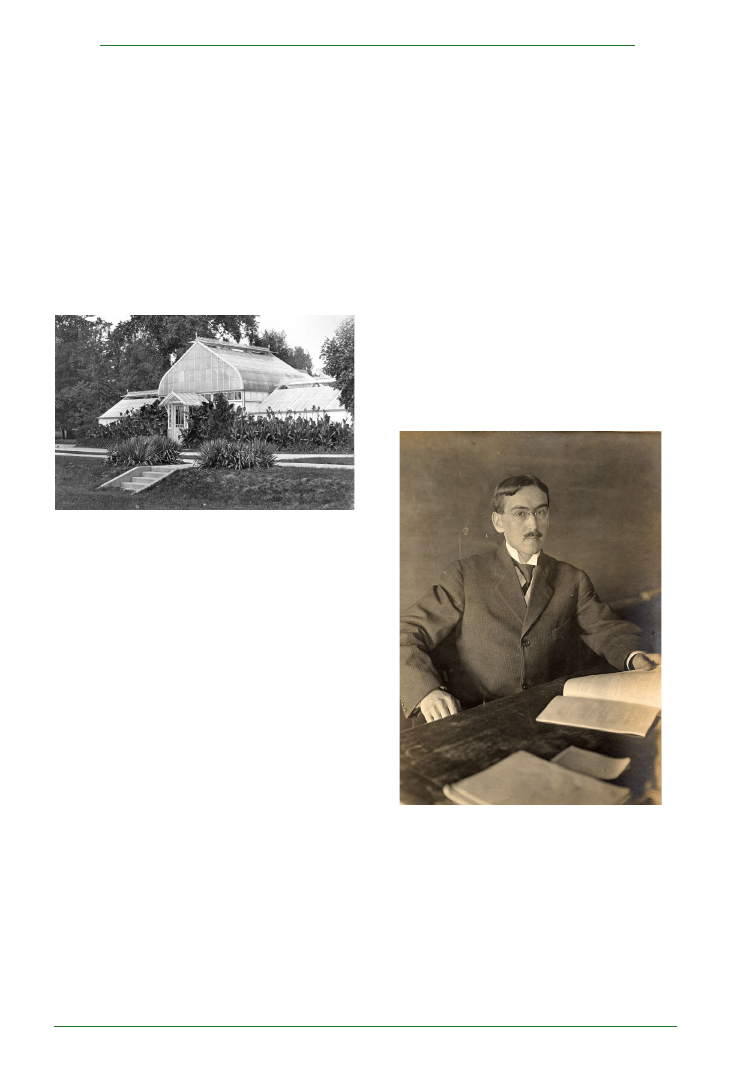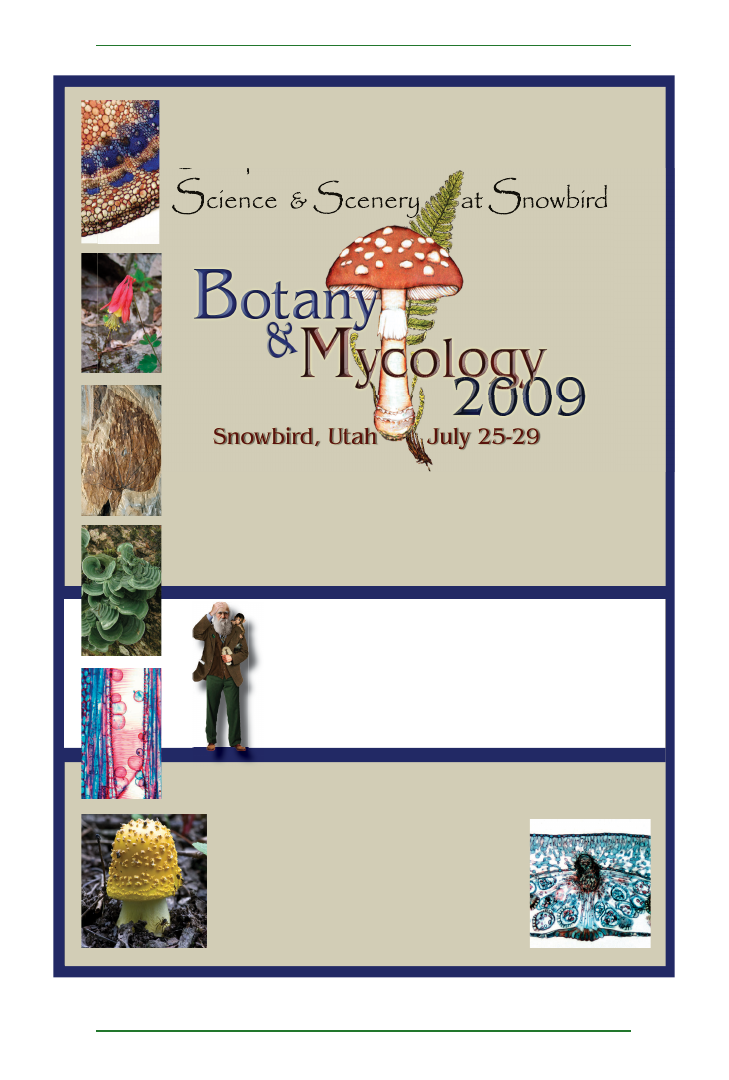
BULLETIN
SUMMER 2009 VOLUME 55
NUMBER 2
2@2
PLANT SCIENCE
ISSN 0032-0919
The Botanical Society of America: The Society for ALL Plant Biologists
THE BOTANICAL SOCIETY OF AMERICA
Leading Scientists
and
Educators
since 1893
News from the Society
Upcoming Annual Meeting
Bringing the Food Back Home: Plants, Algae, Lichens and Fungi in the
Food Traditions of Indigenous Cascadia - Nancy J. Turner..............................50
Women in Science Luncheon and Discussion.....................................................51
BSA Science Education News and Notes...........................................................................51
Editor’s Choice...................................................................................................................54
Applications Solicited, Editor, Plant Science Bulletin, 2010 – 2014 .................................54
Supermarket Botany – A Fresh Approach........................................................................55
Announcements
In Memoriam
Peter Robert Bell 1920 – 2009.........................................................................55
William Ray Bowen 1936-2009........................................................................57
Bernard O. (Bernie) Phinney 1917-2009...........................................................57
Personalia
Peter Crane appointed Dean of the Yale School of Forestry and Environmental
Studies...............................................................................................................59
Debra Edelstein Joins New England Wild Flower Society as Executive
Director..............................................................................................................60
Carnegie’s Arthur Grossman Receives Gilbert Morgan Smith Medal...............61
Nagib Nassar , BSA Member, Celebrates 50 Years Teaching And
Research.............................................................................................................61
Dr. Susan Pell, Brooklyn Botanic Garden Scientist, Returns from
successful Plant Research Expedition in Papua New Guinea............................62
Award Opportunities
Grants for Ornamental Horticulture..................................................................63
Symposia, Conferences, Meetings
I International Orchid Symposium, January 12-15, 2010, Taichung, Taiwan...63
56
th
Annual Systematics Symposium Missouri Botanical Garden....................64
VII International Congress of Systematic and Evolutionary Biology. ..............64
Other News
Lecture Celebrates Monumental Anniversaries of Two Botanical Gardens......................65
A Garden to Die For: Wicked Plants at Brooklyn Botanic Garden...................................65
Reports and Reviews
Botany at Eastern Illinois University................................................................................66
Books Reviewed................................................................................................................76
Books Received
..................................................................................................................................86
Botany & Mycology 2009
................................................................................................................88

50
Plant Science Bulletin 55(2) 2009
P
LANT
S
CIENCE
B
ULLETIN
POSTMASTER: Send address changes to:
Botanical Society of America
Business Office
P.O. Box 299
St. Louis, MO 63166-0299
E-mail: bsa-manager@botany.org
Address Editorial Matters (only) to:
Marshall D. Sundberg, Editor
Dept. Biol. Sci., Emporia State Univ.
1200 Commercial St.
Emporia, KS 66801-5057
Phone 620-341-5605
E-mail: psb@botany.org
ISSN 0032-0919
Published quarterly by Botanical Society of America, Inc., 4475 Castleman Avenue, St. Louis,
MO 63166-0299. The yearly subscription rate of $15 is included in the membership dues of
the Botanical Society of America, Inc. Periodical postage paid at St. Louis, MO and additional
mailing office.
News from the Society
Plenary Address
Bringing the Food Back Home:
Plants, Algae, Lichens and Fungi
in the Food Traditions of
Indigenous Cascadia
Nancy J. Turner
School of Environmental Studies, University of
Victoria, Victoria, B.C., CANADA V8W 2Y2
Indigenous peoples of northwestern North America
are identified by anthropologists mainly as fishers
and hunters. Yet, their traditional food systems
include many, diverse plant species, as well as
some marine algae, lichens and fungi. Plant foods
include roots and other underground parts, green
leaves and stems, many fruits, inner bark of trees,
and a range of beverage teas. These foods
collectively provide essential nutrients and have
been part of a healthy Indigenous diet over
thousands of years. The knowledge required to
use these nutritional resources effectively and
sustainably is part of an overall system of knowledge
that incorporates ecological understanding,
taxonomic, and biogeographical expertise,
specialized practices of harvesting, processing,
and maintaining resource populations, and belief
systems that guide their use and management.
Women have been the holders and practitioners of
much of this plant-based knowledge.
In recent years, for a variety of reasons, many of
these important Indigenous foods have been
declining in use, a dietary trend known as the
“nutrition transition,” that is occurring with local and
Upcoming Annual Meeting
Botany & Mycology 2009
Snowbird, Utah, 25-29 July
This issue continues our series featuring brief
histories of outstanding (or formerly outstanding )
botany departments. Cornell University (PSB 53-3)
and the University of Chicago (PSB 54-1) are major
research universities that are prominent and well-
known for preparing outstanding botanists to lead
the profession. Eastern Illinois University does not
produce Ph.D.’s but it also has a long history of
incubating young botanists and providing
outstanding botanical instruction. As an
undergraduate I was given a copy of Transeau,
Sampson & Tiffany’s Textbook of Botany that I could
use to “supplement” the newer textbook we were
using that was “weaker” in several areas (we were
using Cronquist’s Introductory Botany). I always
associated Transeau with Ohio State (and Otis
Caldwell with the University of Chicago). As you will
read, their formative teaching careers were spent at
Eastern Illinois where they laid the foundation for a
department that thrived until recently when it was
merged with Zoology. I hope you will find Jernegan
et al.’s article to be as interesting a read as I do.
And then the mergers - - the gradual but steady
demise of botany programs has been a concern in
these pages for several decades. In fact, I recently
contacted individuals at more than 60 institutions to
provide updated information about botany courses,
course enrollments, and botany graduates for the
past year (If you were contacted and have not yet
accumulated the data, it’s not too late - - please send
it in). The good news is that we are not alone in our
concern. The Chicago Botanic Garden recently
received a grant from the National Fish and Wildflife
Foundation to help support the “Botanical Capacity
Assessment Project.” Government agencies and
NGO’s are concerned that they cannot find personnel
adequately trained in organismal botany - particularly
taxonomy. We will have an important part to play in
generating data - - you will learn more, hopefully as
soon as the annual meeting in Snowbird.
-The Editor

51
Plant Science Bulletin 55(2) 2009
Editorial Committee for Volume 55
Joanne M. Sharpe (2009)
Coastal Maine Botanical Gardens
P.O. Box 234
Boothbay, ME 04537
joannesharpe@email.com
Nina L. Baghai-Riding (2010)
Division of Biological and
Physical Sciences
Delta State University
Cleveland, MS 38677
nbaghai@deltastate.edu
P
LANT
S
CIENCE
B
ULLETIN
Jenny Archibald (2011)
Department of Ecology
and Evolutionary Biology
The University of Kansas
Lawrence, Kansas 66045
jkarch@ku.edu
Root Gorelick (2012)
Department of Biology
Carleton University
Ottawa, Ontario, Canada, K1H 5N1
Root_Gorelick@carleton.ca
Elizabeth Schussler (2013)
Department of Botany
Miami University
Oxford, OH 45056
schusse@muohio.edu
Indigenous Peoples’ food systems worldwide.
People who once gathered and prepared healthy
local food are turning towards more processed and
marketed foods many of which are high in unhealthy
fats and refined carbohydrates. The result is
increased risk of diabetes and heart disease and
other health problems. Today, Indigenous
communities are using a range of strategies to
maintain and strengthen their use of their original
foods, and have found partners in universities,
NGOs, and government agencies to support this
endeavor. In this presentation, I will describe some
of the diverse Indigenous “wild” foods of the
Cascadia Region, including Angiosperms,
Gymnosperms, and some Algae, Lichens and
Fungi, and discuss the ways in which Indigenous
Peoples have maintained and enhanced these
resources, what has happened to these food
species, and how they are now being reclaimed
and re-incorporated into Indigenous Peoples’
foodways.
Women in Science
Luncheon and Discussion.
The Women in Science Luncheon will be followed
by a panel discussion. Women scientists from
different botanical disciplines and different
backgrounds and career paths will discuss their
experiences. The panel will also respond to
questions from the audience. The organizers
especially encourage their male colleagues to attend
and participate. For more information contact:
Soltis, Pamela S. - University of Florida, Florida
Museum of Natural History, PO Box 117800,
Gainesville, FL, 32611-7800, U.S.A.
Hirsch, Ann M. - UCLA, Department of MCD Biology
and Molecular Biology Institute, 405 Hilgard Avenue,
Los Angeles, CA, 90095-1606, USA.
Poston, Muriel E. - Skidmore College, Biology
Department, 815 N. Broadway, Sarasota Springs,
NY, 12866, USA.
BSA Science Education
News and Notes
BSA Science Education News and Notes is a
quarterly update about the BSA’s education efforts
and the broader education scene. We invite you to
submit news items or ideas for future features.
Contact: Claire Hemingway, BSA Education
Director, at
chemingway@botany.org
or Marshall
Sundberg, PSB Editor, at
psb@botany.org.
PlantingScience — BSA-led student research and
science mentoring program
Watch Us Grow!
That is the line on the T-shirts PlantingScience
teachers and mentors received for participating in
the mentored inquiry sessions. If you served as a
mentor in the Fall or Spring Online Session and did
not receive a T-shirt, let us know. T-shirts,
Certificates of Meritorious Service, and letters of
support are small tokens of our appreciation for your
contributions to change the way students experience
and understand science.

52
Plant Science Bulletin 55(2) 2009
Thanks to you, ~2,140 students in 55 classes had
the opportunity to communicate online with scientists
while conducting plant investigations in their
classrooms. Interest in the project continues to rise
at a rapid pace (another doubling in participation
this year). Your volunteer efforts make this program
possible!
Have you wondered what impact this student-
teacher-partnership might have?
Here are a few thoughts from participants.
“ … Thank you so much for being a great mentor.
You really helped us learn alot! Planting science
was a great way for us to be a part of science! Thanks
agian!” — St. Rose of Lima student
“The part I most liked about this experiment was
communicating with our mentor and learning things
from her. I also liked how other people from other
teams commented our page and how we
commented there page.” — Marshall Middle School
student
“Just wanted to let the mentors know what a fantastic
job they are doing. I love how they are actually
‘guiding’ my students through the scientific thinking
process and not simply telling the students what to
do. Even though some of my students are a bit
frustrated, I like the ‘thinking’ that is going on in their
minds.” — Mark Hurst, Galena High School teacher
“My kids have been really excited…Thanks to ALL
of you for your time to help the kids!...they are
working in small groups, they are discussing and
asking questions-which is GREAT!! I’ve seen that
many have also logged in during non-school hours.
wow.” — Jennifer Forsyth, Woodstock High School
teacher
Over the summer, we will be busy offering teacher
workshops, recruiting new teachers and mentors
for the fall session, and making project
improvements. Please send any suggestions to
psteam@plantingscience.org.
2008 Master Plant Science Team Recognition —
Call for 2009-2010 Applications
Members of the Master Plant Science Team are a
special group of primarily graduate students who
receive a few perks for their commitment to serve for
an academic year and mentor ~4 teams in both the
fall and spring session.
Our deep thanks to the 2008-2009 Master Plant
Science Team. We are grateful for the insights and
extra efforts of those field-testing new inquiries
(underlined below).
The Botanical Society of America sponsored:
Rob Baker, Alona Banai, Katie Becklin, Michelle
Brown, Marian Chau, Nick DeBoer, Frank Farruggia,
Kelly Gillespie, Jennifer Gray, Kandress Halbrook,
Dr. Diana Jolles, Rucha Karve, Rachna Kumar,
Courtney Leisner, Dr. Jason Lando, Julia Nowak,
Amber Roberston, Dr. Aurea Siemens, Roxi Steele,
and Genevieve Walden.
The American Society of Plant Biologists
sponsored:
Brunie Burgos, Eliana Gonzales-Vigil, Lisa Kanizay,
Josh Rosnow, and Ashley Spence.
Would you like to join the 2009-2010 Master Plant
Science Team? Graduate students and post-
doctoral researchers are particularly invited to apply.
For information on perks, requirements, and an
online application form, please see the Scientist
page on
www.plantingscience.org
. Or use the link
below.
h t t p : / / w w w . p l a n t i n g s c i e n c e . o r g /
index.php%3Fmodule=pagesetter%26func=
viewpub%26tid=4%26pid=62
Spotlight on PlantingScience Teachers’
Acheivements
Our hats are off to several teachers in the
PlantingScience program for honors and
recognition they have received for their contributions
to education. Congratulations. Kudos to you.
Naomi Volain – Teacher of the Month in Springfield,
Massachusetts Public Schools, Information and
Instructional Technology Solutions Department.

53
Plant Science Bulletin 55(2) 2009
Naomi participated in last year’s inaugural
PlantingScience Summer Institute, and then in both
the fall and spring online sessions. Naomi has a
long-standing interest in integrating technology in
the classroom and involving students in participatory
science projects, including Forest Watch (from her
alma mater, University of New Hampshire) and
ground-truthing cloud observations for the NASA
CERES S’COOL.
Dr. Michael Hotz – Recipient of Teaching
Environmental Stewardship Award from Science
Pioneers, and his school Wyandotte High School
wins the Kansas Green School Award from the
Kansas Association of Conservation and
Environmental Education.
they strive to support promising students in their
community to pursue independent research through
out their high school years. Read more about the
Fellows Program:
http://www.societyforscience.org/outreach/
FellowsMarch09.pdf
Valdine has been a part of PlantingScience since
2005, and active in developing and field-testing new
inquiry units.
Participating in the Summer Institute and online
session are just a few of Mike’s green education
activities in his school and across the district. The
courtyard gardens, flower and vegetable gardens
he built on the school grounds provide enriching
outdoor learning experiences.
Valdine McLean, Tamica Stubbs, Cappi Coleman
– Society for Science and the Public Fellows.
Ten high school teachers from across the country
were selected to build independent scientific
research in their underserved communities. Three
of the ten members in the inaugural class of the
SSP’s Fellows Program are Planting Science
teachers. What a showing! We wish them well as
Tamica joined the PlantingScience Summer Institute
last year.
Cappi Coleman has participated in PlantingScience
since 2007.

54
Plant Science Bulletin 55(2) 2009
Science Education in the News
Nine steps to transform agricultural education in the
face of changing times — Solving many of today’s
societal problems will rely on innovative
interdisciplinary approaches to scientific agriculture.
The recently released National Research Council
report, Transforming Agricultural Education for a
Changing World, recommends a suite of steps for
colleges and universities with undergraduate
programs in agriculture to prepare students for the
evolving agricultural workplace.
http://www.nationalacademies.org/ag_education
More underrepresented minorities earn PhDs in
science — Hard data show payoffs in programs
aiming to boost participation of underrepresented
minorities in science, technology, engineering, and
math (STEM) fields, according to the recent AAAS
report. The annual percentage of PhDs awarded
across all STEM fields to underrepresented
minorities rose to 33.9% among the 66 institutions
in the Alliances for Graduate Education and the
Professoriate (AGEP). In the biological and
agricultural sciences, the percent of PhDs awarded
to minorities in 2008 increased to 55.9%, up from
38.3% in 2001.
http://nsfagep.org/publications.php
[pdf of report
available under Info Briefs]
http://www.aaas.org/news/releases/2009/
0401minority_phd.shtml
[news release with video
of Shirley Malcom discussing the good news]
What do American adults understand about basic
science? — Unfortunately, only one in five American
adults could answer basic science questions about
life on planet Earth, according to a national survey
commissioned by the California Academy of
Science. Only 53% of respondents know how long
it takes Earth to revolve around the Sun. How does
your science understanding compare? A link to the
online quiz is available on the California Academy
of Sciences’ website.
http://www.calacademy.org/
Editor’s Choice
Chanchaichaovivat, Arun, Bhinyo Panijpan and
Pintip Ruenwongsa. 2008. Yeast biocontrol of a
fungal plant disease: a model for studying organism
relationships. Journal of Biological Education 43(1):
36-39.
This activity demonstrates the inhibitory effect of the
yeast, Saccharomyces cerevisiae, on growth of the
fungal pathogen Botrytis cinerea both in culture and
when inoculated into wounds on fresh red chili
peppers.
Catley, Kelyn M. and Laura R. Novick. 2009. Digging
Deep: Exploring college students’ knowledge of
macroevolutionary time. Journal of Research in
Science Teaching 46: 311-332.
Student questionnaires in a multi-problem booklet
were used to survey students in a large class at a
private research university and a small class in a
private science and technology university. The
students had a range of previous science
coursework from only an introductory course to
several courses including an upper-level course in
evolution. All students underestimated the time
since major historical events (age of the earth, 1
st
fossils, eukaryotic cells, Cambrian explosion, 1
st
mammals, dinosaur extinction, and 1
st
hominids.
Most discouraging was that there was no significant
difference between students with little background,
science majors, and science majors who had
completed an evolution course!
Applications Solicited, Editor, Plant
Science Bulletin, 2010 – 2014
Are you looking for a meaningful way to serve the
Botanical Society of America? Are you interested in
desktop publishing? Would you like to correspond
with botanical colleagues in many disciplines about
books, articles, and matters of interest to the BSA?
The BSA is soliciting applications for the 5-year
position as Editor of the Plant Science Bulletin.
If your answer to ANY of these questions is yes,
please communicate your interest to Dr. Pat
Herendeen (Chair, BSA Publication Committee).
PATRICK HERENDEEN, Chicago Botanic Garden,
1000 Lake Cook Road, Glencoe, 60022 Phone:
202/994-5828, 847-835-6956. E-mail
pherendeen@chicagobotanic.org
Applications are welcome any time and no later
than July 1, 2009. The BSA Publication Committee
will begin reviewing interested candidates during
summer of 2009.
For a description of the Plant Science Bulletin see:
http://botany.org/plantsciencebulletin/

55
Plant Science Bulletin 55(2) 2009
.
Announcements
In Memoriam:
Peter Robert Bell
1920 – 2009
Peter Bell, who has died at age 88, was a leader in
the study of the reproductive biology of ferns and
gymnosperms, a pioneering electron microscopist,
and author of the widely-read ‘Diversity of Green
Plants’. He spent much of his career at University
College London, as Professor, Quain Professor
and Head of the Department of Botany and
Microbiology, and Chairman of the Faculty of Science.
Peter was a proud and dedicated botanist and
enthusiast for all of plant life. An enduring interest
in the pteridophytes meant that, for him, Lycopodium,
Selaginella and each of the ferns held great
fascination and wonder. The ‘alternation of
generations’ became the center of Peter’s research
interests. He aimed to understand the changes in
gene expression that accompanied the transition
for sporophyte to gametophyte and back again, and
how these changes were organized to establish the
nature of the generations. He took this on in the
decade before the advent of molecular biology, and
used the techniques of the day, including
autoradiography and early immunocytochemistry,
to search for answers.
His studies involved analysis of the antherdia and
archegonia that were borne by the gametophytes,
fertilization, and the nature and development of the
zygote. Peter became convinced that biochemical
isolation of the cells that gave rise to the gametes
was essential to separate the gene expression of
the gametophyte from that of the gametes and
therefore of the sporophyte that they combined to
establish. This isolation was to be followed by a
purging of the gamete cytoplasm of the RNAs that
were characteristic of the gametophyte, and their
replacement with others that were necessary to
build the very different nature of the sporophyte. It
was in this way that Peter envisioned the sweeping
biochemical changes that stimulated the ‘phase
change’, and that he held were at the center of the
control of the alternation of the generations.
Peter’s work was published widely and includes
more than 100 papers. His ‘Diversity of Green
Plants’ set some of his own work into the broader
context of plant evolution from the algae through the
flowering plants; reprinted several times, this
remains a standard text at colleges and universities
through Europe and the US.
Supermarket Botany – A Fresh
Approach
Geoff Burrows and John Harper
Charles Sturt University, Wagga Wagga
gburrows@csu.edu.au
&
jharper@csu.edu.au
The use of Supermarket Botany is a popular
approach to teaching plant structure and plant life
cycles. It uses a student’s existing knowledge of
everyday food items to explore the differences
between:
·
fruit and vegetables,
·
roots, stems and leaves, and
·
flowers (with ovaries and ovules) and fruits
(with seeds).
We aimed to produce a resource that was botanically
accurate, with a reasonable level of detail and that
was presented in an engaging format. Please see:
http://www.csu.edu.au/research/grahamcentre/
education/
The web site is divided into two main areas:
· a tutorial that explains the differences between
roots, stems and leaves, and also examines the
differences between vegetative and reproductive
tissues, and
· a test (called ‘The Challenge’) that allows students
to apply the knowledge gained in the tutorial.
In ‘The Challenge’ students select an item from
‘The Shelf’ and are then required to select whether
its major component is root, stem, leaf, flower, fruit
or seed. We have done extensive surveys and have
identified the common Supermarket Botany
misconceptions. Thus we are able to customise
the incorrect answer responses to give hints as to
the correct answer. Once the correct answer is
selected students go to the ‘Why?’ page, where
high-quality images provide supporting evidence.
Quantitative testing indicates the web application
has similar learning outcomes to a traditional
laboratory-based session, although it is designed
to support, not replace, hands-on learning. Student
responses include “I understood more in 15 min
(using Supermarket Botany) than 2 hours of textbook
reading.”

56
Plant Science Bulletin 55(2) 2009
great disappointment that never left him. For many
of his later years, Peter lobbied single-handedly to
restore the Quain chair and the department, only
giving up his campaign when enfeebled by age.
Throughout his career and his life, Peter lived
simply and with great independence. His lab,
overlooking Gower Street and on the site of Darwin’s
London residence, boasted fine wooden surfaces
for bench, desk and cupboard, although an alarming
absence of equipment other than microscopes,
and little in terms of technical help or administrative
support – Peter was fond of saying that instruments
were very good substitutes for ideas, and that the
state of decay of a Department could be best
measured by the degree of proliferation of the
secretaries. At home, Peter took great pride in
paneling bathroom, attic and study, measuring
each panel in its anticipated location, taking said
panel to garden, cutting and preparing it, and
screwing with great precision in to place. Lamps,
chairs, and knife and fork handles were fashioned
similarly, fireplaces copper-plated, and
conservatories and greenhouses built! A cistern in
the garden collected rainwater, kitchen refuse was
composted, salads grown, and apples and
damsons turned to jam and jelly.
Peter taught himself German, so that he could read
Hofmeister in the original, and maintained great
enthusiasm for all things German, including his
adored Siemens electron microscopes and BMW
motor cars, throughout his life. He read Die Zeit
every day, with a Wahrig German dictionary in easy
reach. When confronted by a graduate student (RP)
exclaiming an interest not in German but in French,
Peter – with great deliberation – would exclaim ‘But
for what possible reason? And such a (with
exasperation) ‘barbaric language!’
Peter traveled and ‘botanized’ widely. He was fond
of saying that ‘only by visiting the tropics can we see
what plants can really do’. He spent a sabbatical
year at Zurich and one at UC Berkeley, where he
came to admire the great morphologists Ernest
Gifford and Don Kaplan. He loved the mountains of
Europe and the US and maintained enormous
affection for Switzerland and California throughout
his life. Ireland, through Elizabeth’s heritage, Spain
and the northeast of England through Jerry and
Mike Bell’s relocations, were also special places.
The Rioja of Cosme Palacio was Peter’s other
enduring pleasure, and his visit to the La Guardia
winery was the center of his last visit to Spain.
Late in his career, Peter became a visitor to
Buckingham Palace. Once, on the day after an
evening at the Palace, he offered one of us (RP) this
clear advice: ‘Now, Roger, remember this. If ever
Peter took a First class degree in Natural Sciences
from Cambridge.
Peter was a Quaker, and from an early age he held
very strong pacifist beliefs. During the war he was
a conscientious objector, and in the early days of the
Campaign for Nuclear Disarmament, in 1960, was
brought to court for refusing to pay the part of his
income tax that he calculated would be used by the
Government to build nuclear armaments.
Arriving at University College at the very end of the
war, Peter became a part of a coterie of plant
science leaders and thinkers, including Dan Lewis
and Jack Heslop-Harrison, who made the
Department of Botany and Microbiology a center for
plant science research through the 1970s and early
1980s. When the focus shifted toward medical
science in the 1990’s, the Quain chair of Botany (of
which Peter was a prior occupant) remained unfilled,
and when the Department of Biology replaced
Peter’s beloved ‘Botany and Microbiology’, he felt a
Peter Bell was born to a humble family in Whitstable
in Kent, south of London, on February 18, 1920. His
father Andrew was a market gardener who
specialized in tomatoes and apples. His mother
Mabel used the vegetables with which she was
surrounded to develop a quintessentially British
style of cooking – organized around a piece of grilled
or roasted meat served with potatoes, a green
vegetable, and gravy, and with an apple pie or
similar for desert – that both Peter and Elizabeth Bell
continued to practice throughout their lives; these
were taken to the pinnacle of development so that
dinner parties at the Bell household, were notoriously
British but more notoriously delicious.

57
Plant Science Bulletin 55(2) 2009
you are invited, under no circumstance need you
hesitate to accept’.
Peter died of Parkinson’s disease on January 10,
2009, in London. He leaves Elizabeth and Mike Bell
in London, and Jerry Bell in California.
-Roger Pennell – Los Angeles
rpennell@ceres-inc.com
-Hugh Dickinson – Oxford
hugh.dickinson@plants.ox.ac.uk
William Ray Bowen 1936-2009
William Ray (Bill) Bowen, 72, of Maumelle, passed
away at his home Monday, January 19, 2009 following
a long battle with cancer. Survivors include his
beloved wife of 48 years, Janet Bowen; two sons,
Jeffrey Bowen and his wife, Lori, of North Little Rock,
and Scott Bowen and his wife, Kelly, of Little Rock;
grandsons Hunter Bowen and Austin Bowen;
granddaughter, Emma Bowen; and two brothers,
Robert Bowen and John Bowen of Springfield,
Missouri. A sister, Barbara, preceded him in death.
Mr. Bowen was born October 15, 1936, in Iowa City,
Iowa, to the late Esther and William Bowen. He
earned a BA in biology from Grinnell College (Iowa)
in 1960 and an MS and PhD in botany from the
University of Iowa in 1964. He taught botany/biology
at Western Illinois University and Ripon College
(Wisconsin) before joining the faculty of the University
of Arkansas at Little Rock (UALR) in 1975. In 1990,
he joined Jacksonville State University in Alabama
as Head of the Biology Department. He was
instrumental in the modernization of the department,
and in creating the Little River Canyon Field School
and the Little River Canyon Center, a facility shared
with the National Park Service. Mr. Bowen retired
from JSU as Professor Emeritus in 2001 and, in
2002, he and his wife returned to Arkansas.
During his lifetime, Bill was an avid tennis player
and amateur photographer. After relocating to
Maumelle, he participated in the Pulaski County
Master Gardener program and he and Jan developed
a backyard wildlife garden. Together they enjoyed
travel to the western states, Canada, Europe,
Australia, New Zealand, China, Tibet, and Central
and South America.
The family requests that memorials be made to the
JSU Foundation, William R. Bowen Student
Research Fund, c/o Biology Department,
Jacksonville State University, 700 Pelham Rd, N.,
Jacksonville, Alabama 36265.
Bernard O. (Bernie) Phinney 1917-
2009
UCLA and plant biology lost an important member
of their respective communities with the death of
Bernard O. Phinney of heart failure on April 22, 2009
in Los Angeles. Bernie was born July 29, 1917 in
Superior, Wisconsin. He earned a B.A. in 1940 and
a Ph.D. degree with Ernst C. Abbe as his advisor at
the University of Minnesota in 1946. While a Ph.D.
student, Bernie heard a seminar given by George W.
Beadle, which so impressed him that he went to
Caltech to work with Beadle as a postdoctoral
researcher from 1946-1948. It was this experience
that led Bernie to make major scientific contributions
towards understanding the function and metabolism
of gibberellins. His observations were some of the
first to show that this class of plant hormones, which
affect such critical developmental phenomena as
seed germination, stem elongation, and fertilization,
could be understood using a biochemical genetics
approach.
In 1947, Bernie was hired as an instructor at UCLA,
went through the professorial ranks, and became a

58
Plant Science Bulletin 55(2) 2009
Bernie earned numerous awards during his career
including a Research Medal from the International
Plant Growth Substances Association (1982), and
the Stephen Hales award from the American Society
of Plant Biologists (ASPB) (1984). In 1985, he was
elected to the U.S. National Academy of Sciences.
Bernie received a Certificate of Merit for “meticulous
research in plant physiology” (1986) and a
Centennial Award from the Botanical Society of
America (2006). He joined the BSA in 1946 and
remained a member his entire life. He was elected
Honorary Foreign Member of the Japanese Society
of Chemical Regulation of Plants (1988). Bernie
was elected and served as the President of the
ASPB from 1989-1990 and was honored as a
member of the inaugural class of ASPB Fellows in
2007. In 1989, he was awarded an Honorary D.Sc.
from the University of Bristol in the U.K., and a
Research Fellowship from the Japanese Society
for the Promotion of Science in 1991.
Bernie became Professor Emeritus at UCLA in
1988 but he did not slow down. He continued his
research and outreach activities until about two
weeks before he died. Well into his 90’s, Phinney
continued his research in the UCLA Plant Growth
Center, usually testing an extract of marah
(Cucurbitaceae) on dwarf mutants of Arabidopsis.
He also tested various gibberellins on some dwarf
mutants of Melilotus alba Desr. (white sweetclover)
that my lab studied. Bernie loved our new Plant
Growth Center and spent a great deal of time
working with his plants, almost daily. It was very
important for him to keep on doing research even
after years of retirement. After being in the Botany
Building for more than 40 years, his office was
moved to the 3rd floor of the Life Sciences Building
near other labs working on Arabidopsis. Here he
had the opportunity to interact with graduate
students and postdocs, helping them by writing
them letters of recommendation, and giving advice.
He loved relating anecdotes about science and
stories about people he had know.
In addition to his enthusiasm for plants, especially
for the ferns and orchids that he grew in his home
greenhouse, Phinney loved skiing, fishing, eating
sushi (actually, he liked everything Japanese,
including art and architecture), and listening to
classical music, often when driving in his fiery red
convertible with the top down. He used to drive a VW
camper with the license plate GA1. As a one-time
passenger in this vehicle, I can tell you that driving
down Wilshire Boulevard with Bernie at the wheel
was an experience not to be forgotten.
His wife Jean; four children, Scott Phinney, Katcha
Burnett, Peter Phinney, and David Phinney; and
eight grandchildren survive him. The Phinney family
will be holding a memorial service for Bernie at their
full professor in 1961. It was during his early years
at UCLA, however, that Bernie began to test the
concept of linkage between phenotype and
genotype. In this research, he showed that dwarf
mutants of maize became tall if given an external
application of gibberellin, showing that dwarfness
was linked to a deficiency of this hormone. Because
maize dwarfness segregates as a Mendelian
recessive, the results strongly suggested that the
mutation occurred in a single gene. This seminal
research paper was published in 1956 in the
Proceedings of the National Academy of Sciences.
The findings were so insightful that they were later
incorporated into textbooks along with the classic
picture of dwarf maize before and after gibberellin
treatment. A 1957 paper in the same journal co-
authored with Charles A. West, Mary Ritzel, and
Peter M. Neely of UCLA identified gibberellin-like
substances from a number of different families of
angiosperms. Although Japanese scientists had
already discovered gibberellin production by the
fungus, Gibberella fujikuroi, the causative agent of
“foolish seedling disease”, Bernie and his graduate
student Calvin Spector identified a gene controlling
a step in gibberellin biosynthesis. These three
papers set the stage for Bernie’s lifelong synthesis
of chemical, genetics, and physiological
approaches to answer research questions. He
and his co-workers, many from the U.K. such as
Jake MacMillan and Clive Spray, or from Japan,
Nobutaka Takahashi, Saburo Tamura, and
Masayuki Katsumi, later elucidated the various
biochemical pathways required for the synthesis of
several distinct gibberellins.

59
Plant Science Bulletin 55(2) 2009
home in Los Angeles, CA on Saturday, May 30, at 3
p.m. Contributions in Bernie’s memory can be sent
to: the Bernard and Jean Phinney Graduate
Fellowship in Plant Molecular Biology, University of
Minnesota Foundation, 200 Oak St SE, Suite 500,
Minneapolis, MN 55455.
-Ann M. Hirsch, Department of Molecular, Cellular
and Developmental Biologoy, UCLA, Los Angeles,
CA.
May 1, 2009
Bernie and I got to know each other one hot summer
(in the early 50s) in the cornfields of Minnesota. I
was a grad student, he a relatively new Ph. D. We
were charged with propagating Ernst Abbe’s dwarf
corn stocks. I have no doubt that observing the
diversity of dwarfs expressing differently on four
different inbred lines must have tweaked his
scientific curiosity. I remember him as a friendly,
sociable person, always showing concern for the
individual. Thus at scientific meetings, he did not
take kindly to people who would leave the room
before the last (often young) speaker was finished.
His interest in people persisted throughout his life.
He was careful in preserving his individuality whether
in unusual clothing or riding in his convertible car,
which ran on bald tires. It did serve him well,
however, in attracting good-looking coeds!
At the end of the summer, Bernie left for the West,
carrying with him some of the corn. He did well until
he was stopped at the Arizona-California border by
agricultural inspection and told to shell all the corn
off the cobs. Bernie spent the day there shelling
corn!
We continued to keep in touch—primarily through
science meetings but also when he came East to
visit relatives. On the way, he would always stop by
the old botany building and visit with his (and mine)
old advisor, Ernst Abbe. One summer it misfired.
Bernie had come to collaborate with Abbe on a
paper. Abbe decided to spend his time refinishing
the floors of his house instead. Bernie was not
amused. But to his credit he continued his loyalty
even to Abbe’s last years, when visiting him surely
must not have been easy.
All of us rejoiced when Bernie became a member
of the National Academy. Being Bernie, this honor
did not change him—he continued to be the same
decent and modest person we all knew.
-Otto L. Stein, 140 Red Gate Lane, Amherst, MA
01002
413-253-9572
Personalia
Peter Crane appointed Dean of the
Yale School of Forestry and
Environmental Studies
(Media-Newswire.com) - New Haven, Conn. —
President Richard C. Levin has appointed the
distinguished evolutionary biologist Sir Peter Crane
as dean of the Yale School of Forestry and
Environmental Studies.
The John and Marion Sullivan University Professor
in the Department of Geophysical Sciences at the
University of Chicago, Crane is the former director
of England’s renowned Royal Botanic Gardens,
Kew. Earlier in his career he also led the scientific
programs at the Field Museum of Natural History in
Chicago.
“Peter’s impressive record of research and
conservation achievements and his stellar
leadership of important scientific organizations will
make him a superb dean of Yale’s environment
school,” Levin said. “I am confident that he will add
to the school’s century-long legacy of leading
research and education in an era when advancing
knowledge of the natural world and mankind’s
impact on it has never been more important.”
Crane’s research is focused on the diversity of plant
life; its origin and fossil history, its current status,
and its conservation and use. Seeking to understand
large-scale patterns and processes of plant
evolution, he has worked extensively on questions
relating to the origin and early diversification of
flowering plants and, together with Paul Kenrick,
published “The Origin and Diversification of Land
Plants” in 1997. He has written several other books
and nearly 200 articles and essays.
Prior to his current appointment at the University
of Chicago, Crane served from 1999 to 2006 as
director and chief executive of Kew, one of the
most influential botanical gardens in the world.
At Kew, which has the world’s largest and most
comprehensive collection of living plants, Crane
worked on the initial establishment of the
Millennium Seed Bank and a variety of other
programs in plant conservation.
He directed the Field Museum from 1995 to 1999,
where he established the Office of Environmental
Programs and had overall responsibility for the
museum’s work in science and conservation. His
association with the Field Museum began in 1982,
and he served as curator, department chair and
vice-president. At the University of Chicago, Crane
was a professor in the Department of the

60
Plant Science Bulletin 55(2) 2009
Debra Edelstein Joins New
England Wild Flower Society as
Executive Director
Framingham, MA - New England Wild Flower Society
announced today the appointment of Debra
Edelstein as its Executive Director. Society Board of
Trustees Chair Frances H. Clark stated, “The Board
of Trustees is delighted to welcome Debbi as the
new leader of New England Wild Flower Society.
She brings a deep commitment to conservation
and a breadth of experience in managing non-profit
organizations. We were impressed by her
enthusiasm, expertise, and creativity and voted
unanimously for her to lead us in the challenge and
excitement of these coming years. The native plants
will thrive under her charge.”
Edelstein started February 17 and manages the
Society’s headquarters and staff at the 45-acre
botanical museum Garden in the Woods,
Framingham; Nasami Farm and Sanctuary,
Whatley; conservation programs; education
programs; and ten sanctuaries located throughout
New England.
In her most recent position at NESCAUM, the
regional organization that provides scientific and
policy expertise to the air agencies of the eight
Northeastern states, she established a new
collaborative effort by the states and the US EPA to
reduce diesel emissions, secured $15 million in
new project funding, created industry workgroups
and multi-state task forces, and organized
successful public workshops.
As Vice President and Executive Director of National
Audubon Society/Audubon Washington, she
published the country’s first “State of the Birds”
report, garnered a unanimous legislative vote for a
first-in-the-nation state law adopting Audubon’s
Important Bird Areas into the Natural Heritage
Database used for land use and management
decisions on both public and private land, produced
the first “State of Environmental Education” report at
the request of the Washington legislature, and
provided fiscal stability to Audubon Washington.
As Bioreserve Project Manager for The Trustees of
Reservations, she led the Trustees’ role in creating
the 13,600-acre Southeastern Massachusetts
Bioreserve, the Commonwealth’s largest land-
protection project.
She has also been a consultant offering
environmental planning, education, and
communication services, a marketing director,
editor, and writer. She holds a MCP (Master in City
Planning) in Environmental Policy and Planning
from Massachusetts Institute of Technology, and
an AB in English from Bryn Mawr College.
“We look forward to an exciting, extended period of
leadership by Debra Edelstein. She is poised to
take the next steps to bring New England Wild
Flower Society to even greater heights of national
awareness, while realizing our conservation
mission, horticultural interests, and educational
prowess,” concluded Board of Trustees Chair Clark.
Founded in 1900, New England Wild Flower Society
is America’s oldest native plant conservation
organization, promoting the conservation of
temperate North American flora through education,
research, horticulture, habitat preservation, and
Geophysical Sciences from 1992 to 1999.
He earned his B.Sc. and Ph.D. in botany at the
University of Reading, United Kingdom. He is a
Fellow of the Royal Society, a Foreign Associate of
the U.S. National Academy of Sciences, a Foreign
Member of the Royal Swedish Academy of Sciences
and a member of the German Academy Leopoldina
and member of the Botanical Society of America. He
was a Senior Mellon Fellow of the Smithsonian
Institution and serves on the board of the
Smithsonian’s National Museum of Natural History.
Crane also serves on the boards of the Global Crop
Diversity Trust based at the United Nations Food
and Agriculture Organization in Rome, and the
Gaylord and Dorothy Donnelley Foundation, which
facilitates land conservation in the Chicago area
and the low country of South Carolina.
He was knighted in the United Kingdom in 2004 for
services to horticulture and conservation. His many
awards include the Schuchert Award of the
Paleontological Society, the Henry Allan Gleason
Award of the New York Botanical Garden, the
Hutchinson Medal of Chicago Botanical Garden
and the Botanical Society of America Centennial
Award.
Crane’s appointment at Yale as the Carl W.
Knobloch, Jr. Dean is effective September 1, 2009.
He succeeds James Gustave Speth, who Levin
said has provided “superb leadership” since 1999.
“The new dean will inherit a school that has seen
remarkable growth in faculty, student applications,
and the availability of scholarship assistance over
the past 10 years,” Levin said. “Dean Speth, a
passionate advocate for a greener Yale, has played
a key role in increasing national and international
awareness of climate issues.”

61
Plant Science Bulletin 55(2) 2009
Carnegie’s Arthur Grossman
Receives Gilbert Morgan Smith
Medal
Stanford, CA—The National Academy of Sciences
has awarded Arthur Grossman, of the Carnegie
Institution’s Department of Plant Biology, the 2009
Gilbert Morgan Smith Medal “in recognition of
excellence in published research on marine or
freshwater algae.” The award was established
through the Helen P. Smith Fund.
Grossman is a pioneer in studying a broad range
of topics about Chlamydomonas, a tiny green alga
affectionately called Chlamy, which is present in
soil and freshwater. He also brought Chlamy into
the age of genomics by leading the project that
helped to define its full genome sequence and then
exploiting the genomic information. Chlamy
performs photosynthesis like plants, but it diverged
evolutionarily from flowering land plants about 1
billion years ago and therefore contains many
characteristics common to all plants, as well as
characteristics associated with animals but not
with flowering plants. Grossman’s research is
important both for understanding basic
mechanisms in photosynthetic organisms as well
as their evolution. He has investigated metabolic
processes and the acclimation of algae and
cyanobacteria (formerly called blue-green algae) to
changing environmental conditions, the diversity of
genomes of photosynthetic microbes in hot spring
mats and the physiological functions encoded by
those genomes, and energy use by photosynthetic
microbes in the marine environment. In addition, he
is part of a team working with new methods to study
gene expression or transcriptomics in alga.
“Art is recognized worldwide as a major figure
shaping our understanding of algae,” remarked
Carnegie president Richard A. Meserve. “We
congratulate him on this honor.”
Grossman has been a staff scientist at Carnegie
since 1982 and professor by courtesy at Stanford
University. He received his B.S. from Brooklyn
College, and his Ph.D. from Indiana University.
Grossman received the prestigious 2002 Darbaker
Prize for his microalgae work from the Botanical
Society of America. He has served on numerous
panels and editorial boards, including Current
Genetics, Eukaryotic Cell, Molecular Plant, Plant
Physiology and the Annual Review of Genetics. He
regularly reviews papers for journals such as
Science, Nature and PNAS.
Nagib Nassar , BSA Member,
Celebrates 50 Years Teaching And
Research
My love of plants goes back to very early life at the
age of 12 onwards, planting shrubs in our house
garden, accompanying their growth and thinking in
them every moment. They were my enjoyment, my
hobby and my entertainment. At the University I
began to examine flowers and learn about their
systematics. This opened for me the door to a very
exciting world of botany in which I live up to this date.
For my Ph.D. study I applied cytogenetic data to the
taxonomy of Chenopodiaceae in what is known
now as cytotaxonomy.
My fifty years teaching were divided into 16 years
with Cairo University from 1958 to 1974 and 34
years with the University of Brasilia. This multi-
cultural experience exposed me to a broad range of
learning styles and allowed me to acquire a number
of different teaching methods. At Cairo University I
taught horticulture and conservation of plant genetic
resources. At Brasilia I taught plant breeding, organic
evolution, evolution of cultivated plants, basic
cytogenetics, cytogenetics methods and
techniques, economic botany, plant breeding of
perennial crops, and botany of Cassava to both
graduate and post-graduate students. I have taught
several of these courses at the federal universities
of Goias, Vicosa, Rio Grande do Sul, Brasilia, Feira
Santana, and Sao Paulo in Brazil, the Pan American
center in Costa Rica, and Bern University in
Switzerland.
advocacy. The Society’s vision is a future where
vigorous native plant populations live in healthy,
balanced, natural ecosystems-protected, enjoyed,
and beneficial to all life.
Professor Nassar with students at the University
of Brasilia

62
Plant Science Bulletin 55(2) 2009
Conserving wild cassava, Manihot species native
to Brazil and Mexico. was the most fascinating work
in my career, which began 35 years ago. My
knowledge of the botany of this group enabled me
collect and conserve them and manipulate them for
crop improvement. I emphasize to my students that
knowing the botany of a certain crop is the principal
step towards improving it. You cannot successfully
use a wild species in an improvement program or
breed it with cultivated forms without knowing in
what habitat it grows. This provides clues to
important characteristics that may be incorporated
into the cultivar. Breeders must also understand the
reproductive system of his crop to choose adequate
methods of breeding.
-Nagib Nassar, Departamento de Genética e
Morfologia, Instituto de Ciências Biológicas,
Universidade de Brasília, Campus Universitário,
Darcy Ribeiro, Asa Norte, 70910–900, Brasília –DF,
Brazil
Phone: (+55.61) 307.20.22; Fax:(+55.61) 272.00.03;
Email:
nagnassah@rudah.com.br
Dr. Susan Pell, Brooklyn Botanic
Garden Scientist, Returns from
Successful Plant Research
Expedition in Papua New Guinea.
Brooklyn, New York – March 10, 2009. Dr. Susan
Pell, Brooklyn Botanic Garden Scientist, and
member of the Botanical Society of America, recently
completed the first botanical survey of the three
main islands of Papua New Guinea’s Louisiade
Archipelago in 50 years.
Throughout the five-week adventure, Dr. Pell, the
Garden’s plant systematist and laboratory manager,
worked with BBG’s web team to keep a blog detailing
her team’s challenging work climbing mountains,
fording rivers, and sleeping on a small boat in order
to make over 800 plant collections that are sure to
greatly expand the existing knowledge of the Milne
Bay flora.
Their exploration and study of the three main islands
of the Louisiade Archipelago, Misima, Rossel, and
Sudest, is key: These islands are home to many
species found nowhere else in the world. The work
done in Papua New Guinea by Dr. Pell and her team
include the collection of a plant that has been
collected only twice before – and never described –
My teaching experience has been very rewarding. It
is from my experience with teaching that I
have gained my greatest strength. Teaching for me
was like composing a piece of music, and for years
and years I had the aspirations of being admired by
my students the same way they admire their idols
of musicians and artists. I always try to create a
strong friendship with my students from the moment
they joined my class up to their graduation.
In 1975, I began my first mission to collect wild
Manihot species in Brazil on behalf of IITA
(International Institute of Tropical Agriculture). I was
at that time a visiting scientist sponsored by the
Brazilian Ministry of Foreign Relations stationed at
the University of Sao Paulo. The financial support of
IITA was so small that did not permit me to hire any
assistant to accompany me in my collection trips. By
the end of four months trips I was able to collect
seeds of more than 20 wild species native to 8
Brazilian states.
Collecting wild species for IITA encouraged me to
plant and propagate a living collection at the
Universidade de Brasilia. My goal was not only to
propagate and conserve them but to use them for
crop improvement. Five years later, I was able to
provide IITA with hybrid seed that gave rise to
cultivars now planted on about 4 million hectares in
Nigeria making it the top-ranking producer of
cassava all over the world. “Your breeding approach
shows the benefits of preserving biodiversity … for
enhancing casava germplasm…[and]new
methods for the propagation of this crop…” says
Rodomiro Ortiz , director of IITA.
See
http://www.geneconserve.pro.br/iita2.gif
a n d
h t t p : / / w w w . g e n e c o n s e r v e . p r o . b r /
decades_of_cassava.pdf
The success of my work on wild Manihot in the
decade 1970s encouraged the International Board
of Genetic resources-IBPGR to delegate me for a
mission of 3 months collecting wild Manihot native
to Mexico. Since the1980s I continued working
on cassava and for the last decade I have
concentrated on embryology of this group . This led
me to the most important discovery ever made in
these species, the discovery of apomixis and
transference of its genes to cultivated forms,
producing the first apomictic cultivars of this crop.
This shows how much botany could serve breeding
programs and botanists.
Most recently I was involved in developing cassava
hybrids that are rich in protein. The first such hybrid
was bred by me early in the 1980s. We can now
release hybrids that are very productive and contain
high protein and essential amino acids.

63
Plant Science Bulletin 55(2) 2009
giving the explorers a rare glimpse into some of the
world’s most exciting flora.
The five-week expedition was more than five years
in the planning. Dr. Pell and her five-member team,
including scientists from New York Botanical
Garden, Botanical Research Institute of Teas, and
Conservation International, set out in early January
to work with local naturalists to survey the flora of the
area, compile a conservation assessment, and
identify members of the cashew and frankincense
plant families. Data from the project will become an
integral part of an online tree flora database of New
Guinea, and new plant specimens will be housed
in the PNG National Herbarium, BBG’s herbarium,
and other herbaria in Papua New Guinea and
stateside.
Throughout her trip, Dr. Pell’s blog, Expedition:
Papua New Guinea, provided a gripping, frontline
reality show imbued with all the challenges and
curiosities that only a scientist can capture and
share. And Dr. Pell’s stunning photos offer a
window into a part of the world few have ever seen,
especially in such a personal way.
Dr. Pell was selected as a Wings WorldQuest
Foundation explorer for this expedition. The
foundation is the leading resource and advocate for
women explorers worldwide. Dr. Pell will be
available for interview to recount her incredible field
research experience and the making of her web
diary:
bbg.org/blogs/expedition
.
Contact: Leeann Lavin,
LeeannLavin@bbg.org
or
718-623-7289 to arrange interviews.
GRANTS FOR ORNAMENTAL
HORTICULTURE
The Stanley Smith Horticultural Trust invites
applications for grants up to $20,000 for education
and research in ornamental horticulture. Not-for-
profit botanical gardens, arboreta, and other tax-
exempt organizations are eligible.
The deadline for applications is August 15, 2009.
For current guidelines, send a brief message that
indicates a potential project and identifies your
organizational affiliation to: Thomas F. Daniel, Grants
Director, SSHT, Dept. of Botany, California Academy
of Sciences, 55 Music Concourse Dr., Golden Gate
Park, San Francisco, CA 94118, USA email:
tdaniel@calacademy.org
Award Opportunities
Symposia, Conferences,
Meetings
International Orchid Symposium
January 12-15, 2010
Taichung, Taiwan
Welcome to the first International Orchid
Symposium, organized by the International Society
for Horticultural Science (ISHS) Orchid Working
Group. Academics, scientists, and industry leaders
are invited to participate in the sharing of research-
based information on orchids.
This meeting will be held January 12-15, 2010 in
Taichung, Taiwan. Taiwan is home to large-scale
commercial production of orchids, particularly
phalaenopsis, as well as numerous scientists
focused on orchid research.
The primary topics of the meeting are:
1. Orchid anatomy and morphology
2. Orchid ecology
3. Orchid genetics and breeding
4. Orchid micropropagation and seed
germination
5. Orchid production (including pest and virus
control)
6. Orchid postharvest and marketing
This symposium will be held at the National Museum
of Natural Science (NMNS,
http://www.nmns.edu.tw
)
in the downtown of Taichung City (the west-central
region of Taiwan). There are two lecture theaters
(each with a capacity of 200 people) with modern
facilities for holding the international symposium.
International symposium participants are
encouraged to arrive into Taoyuan International
Airport (formerly known as Chiang Kai-shek
International, or C.K.S. airport.), which is located
outside of Taipei. From Taoyuan International
Airport, it takes about 2 hours to reach Taichung City
by bus.
For more information see:
http://www.hrt.msu.edu/ios/

64
Plant Science Bulletin 55(2) 2009
VII International Congress of Systematic and Evolutionary Biology,
ICSEB 7
“Extending the Darwinian Panorama”
Veracruz, Mexico
5-10 July 2009
for more informaiton see:
http://www.botanik.univie.ac.at/ICSEB7/
56
th
Annual Systematics Symposium Missouri Botanical Garden
“Angiosperm phylogeny: not just trees, but insects, fungi, and much more”
9-11 October 2009 With support from the National Science Foundation
REGISTRATION
SATURDAY-SUNDAY, October 10-11
Kevin Boyce: Ecophysiology of early angiosperm evolution
Bryan Danforth: Bee phylogeny and angiosperm diversification
Peter Endress: Floral morphology and eudicots
Else-Marie Friis: Early angiosperm fossils
Thomas Givnish: Whole genomes and major branchings in monocots
Conrad Labandeira: Paleohistory of plant/insect interactions
Paula Rudall: Monocot floral development and diversification
Vincent Savolainen: Phylogeny of the monocots
Christopher Schardl: Endophytes and plants, especially Poaceae
Doug Soltis: Broad-leaved angiosperm diversification
SPACE LIMITS REGISTRATION TO 400; PLEASE REGISTER EARLYRegistration must be accompanied
by an $85.00 registration fee, which also covers the cost of refreshments at the Friday mixer and lunch
and dinner on Saturday. Information on local hotels and motels will be available to registrants. No refunds
will be granted after 24 September. There is no guarantee of food being available if you register after 30
September. For electronic payment, see future updates on symposium webpage.
I plan to attend the Systematics Symposium. Enclosed is my $85.00 registration fee. Please make checks
payable to “Missouri Botanical Garden” I enclose my registration fee of $85.00 _____
I request vegetarian meals: _____
My name and professional address: ________________________________________________
______________________________________________________________________________
______________________________________________________________________________
______________________________________________________________________________
Phone:___________________ Fax:_________________ e-mail address:_____________
Please indicate if you are a)a graduate student _______ or b)an undergraduate student _______
Mail registration form to: Systematics Symposium Missouri Botanical Garden P.O. Box 299 St. Louis,
MO 63166-0299 For further information, contact: P. Mick Richardson Email:
mick.richardson@mobot.org
Tel: 314 577 5176 Fax: 314 577 0820

65
Plant Science Bulletin 55(2) 2009
Other News
Lecture Celebrates Monumental
Anniversaries of Two
Botanical Gardens
“Kew, Missouri Botanical Garden and
the Global Botanical Network –
Powerhouse for a Better Future,”
Professor Stephen D. Hopper
Director of Royal Botanic Gardens, Kew
WHAT: “Kew, Missouri Botanical Garden and the
Global Botanical Network – Powerhouse for a Better
Future,” a lecture by Professor Stephen D. Hopper,
director of the Royal Botanic Gardens, Kew
WHEN: Monday, June 1, 2 p.m.
WHERE: Monsanto Center, 4500 Shaw Blvd., south
St. Louis (two block west of the Missouri Botanical
Garden at the Shaw-Vandeventer intersection)
NFO:
www.mobot.org;
(314) 577-9400, 1 (800)
642-8842 toll free
As the Missouri Botanical Garden celebrates 150
years of botanical research, science education and
horticultural display, the Royal Botanic Gardens,
Kew, near London is celebrating its 250th
anniversary. Join Kew director and plant conservation
biologist Professor Stephen D. Hopper for a lecture,
“Kew, Missouri Botanical Garden and the Global
Botanical Network – Powerhouse for a Better Future,”
on Monday, June 1 at 2 p.m. at the Missouri Botanical
Garden’s Monsanto Center, 4500 Shaw Blvd. The
event is free and open to the public.
Hopper is best known for pioneering research
leading to positive conservation outcomes in
southwest Australia (one of the few temperate-zone
global biodiversity hotspots). He collaborated on
the descriptions of 300 new plant taxa and has
authored over 200 scientific publications. Hopper
has explored Australian deserts since 1980, and
conducted research in South Africa and the USA.
As Foundation Professor of Plant Conservation
Biology at the University of Western Australia from
2004 to 2006, he developed new theories on the
evolution and conservation of biodiversity on the
world’s oldest landscapes, and led the
establishment of new degrees in conservation
biology.
The Missouri Botanical Garden and the Royal
Botanic Gardens, Kew share a unique connection.
From 1849 to 1851, Missouri Botanical Garden
founder Henry Shaw traveled extensively in the
United States and Europe. During one of his trips to
England, Shaw was inspired to give the people of
St. Louis a garden like the great gardens and
estates of Europe. Shaw was encouraged to build
a garden involved with scientific work like the great
botanical institutions of Europe. With the assistance
of Harvard botanist Asa Gray and Sir William Hooker,
director of the Royal Botanic Gardens at Kew at the
time, Shaw was persuaded to include a herbarium
(collection of botanical specimens) and a library.
A Garden to Die For: Wicked Plants
at Brooklyn Botanic Garden
The awesome power of plants is on display this
summer with Wicked Plants at Brooklyn Botanic
Garden, from May 31 through September 6, 2009.
Although plants have nourished and succored,
seduced and delighted humans throughout history,
this summer, BBG highlights a rogue’s gallery of
the most nefarious, troublesome, and even
potentially deadly members of the plant kingdom.
Wicked Plants at Brooklyn Botanic Garden
introduces visitors to over 50 plants in the Garden
whose capacity to injure, poison, or perhaps just
irritate humans is a powerful reminder to tread
lightly in the plant world.
Inspired by the upcoming release of author Amy
Stewart’s Wicked Plants: A Book of Botanical
Atrocities, Brooklyn Botanic Garden’s summer
interpretive highlight gives visitors a closer look at
the sometimes problematic relationship between
people and plants. In ten areas throughout the
Garden, on-site text and the Garden’s first-ever
audio tour, featuring its science and horticulture
staff, share facts, advice, and tales of close
encounters with wicked plants. Visitors will learn
about such botanical menaces as monkshood
(Aconitum sp.), a member of the buttercup family
used to tip spears for killing prey—and people; ricin
(Ricinus communis), an extract of the castor bean
that was used to poison a Bulgarian dissident in the
1970s; and the jumping cactus (Cylindropuntia
fulgida), which terrorizes hikers by seeming to leap
onto clothing or exposed skin.
Yet, for every “villainous” aspect of a particular plant,
BBG’s interpretation will shed light on plants’
redemptive characteristics. The foxglove (Digitalis
species), for example, tellingly also called “witch’s
gloves” or “dead man’s bells,” causes violent
reactions when ingested; but the plant is also used
to make digitalis, which helps regulate the human
heart—a boon to victims of cardiac distress.

66
Plant Science Bulletin 55(2) 2009
Reports and Reviews
Botany at Eastern Illinois
University
Marissa C. Jernegan Grant, Nancy E. Coutant,
and Janice M. Coons
Biological Sciences Department, Eastern Illinois
University, Charleston, IL 61920
ABSTRACT
Eastern Illinois University was established in 1899,
and from its beginning the importance of the
botanical sciences was recognized. Two terms of
botany were required for the four year program. Dr.
Otis W. Caldwell, a botanist, was one of the original
faculty members. He taught all of the biology courses
and initiated the acquisition of a greenhouse.
Caldwell was the first in a series of talented and
dedicated botany professors including Edgar N.
Transeau, Ernest L. Stover, Hiram F. Thut and John
E. Ebinger. These and many other professors
incorporated a field component into almost all
classes. This dedication to the study of plants in
their natural habitat led to one of the finest programs
in the nation for training field botanists. By 1923, a
formal Botany Department was established and in
the late 1960’s EIU began awarding a M.S. in
Botany. In the 60’s, the department greatly expanded
with 15 faculty hires and over 40 different
undergraduate and graduate courses were offered
with 95% having a lab component. The excellence
of the program was recognized in Illinois where
organizations such as the Illinois Department of
Natural Resources and the Illinois Natural History
Survey relied on graduates from the EIU Botany
Department for their field botanists. In 1992, the
American Phytopathological Society recognized the
department for its contribution to plant pathology.
Between 1913 and 1993, six hundred and nine
students graduated with degrees in Botany, and
121 continued to receive their doctorates in botanical
fields. Although numbers of botany majors rose
during early to mid 1990’s, an administrative
decision was made in 1998 to combine the Botany
Department with the Zoology Department into a
Biological Sciences Department. Since the merger,
the B.S. in Botany was eliminated. Unfortunately,
the elimination of this Botany Department is another
example of past national trends to eliminate Botany
Departments even with exceptional reputations.
EARLY YEARS
IIn the past two decades, a trend has occured for
many colleges and universities to allow their plant
biology programs to be replaced with a pre-medical
or cellular and molecular biology curriculum
(Salopek, 1996). Occasionally, independent
departments focusing separately on botany and
zoology are merged, thus squeezing botany classes
into the general biology degree where often they
lose their individual niche. According to the Chicago
Tribune, a misguided emphasis is placed on “big
science,” keeping researchers in the lab and
students in the classroom instead of exploring the
outdoors and discovering what field botany offers
(Salopek, 1996). Eastern Illinois University
dissolved its nationally recognized Botany
Department in 1998. The program had a very strong
organismal focus. With more and more botany
programs disappearing or condensing, we were
inspired by the Historical Section at the 2007
Botanical Society of America meeting to report on
the history of the once renowned Botany Department
at Eastern Illinois University.
Eastern Illinois Normal School was established in
September of 1899. The City of Charleston had
donated “Bishop’s Woods,” a 40-acre tract, to the
cause of the Normal School. This area was partially
covered by a grove of trees. The north half of this tract
of land, from pictures, was quite well wooded, but
the south half was cleared, presumably for farming
purposes. In this grove was where the one building
(Old Main) for the Normal School was built, along
with its power house some 150 feet directly south.
The two were connected by a heating tunnel. As a
training school for teachers, it offered one, two,
three, and four year teaching diplomas. Botany
classes were one of the first required course
offerings, and interestingly enough, zoology was an
elective. During the tenure of Eastern’s first
president, Mr. Livingston C. Lord, a Biological
Sciences Department was established. The Botany
and Zoology Departments became separate
entities in the early 1920’s. Of the eighteen original
faculty members initially hired by President Lord,
Dr. Otis W. Caldwell, a botanist, was the only faculty
member to hold a doctorate degree (Coutant and
Crofutt, 1996; Thut, 1967). Caldwell taught all of the
biology classes along with coaching the football
team for three years. He was the entire department.
He offered General Botany, (Plant) Ecology, (Animal)
Physiology, and Zoology. General Botany was a two
quarter course, and the course was described in
the university’s catalog as follows: “In this course,
a general survey of the plant kingdom will be made,
beginning with the lowest plants and considering
representative forms through all the great groups.
An attempt will be made to show some of the
relationships existing between the various groups.
Throughout this course, the points of view will be
those of morphology and physiology, while sufficient
attention will be given to taxonomy to give
acquaintance with quite a number of plants, which
may be looked upon as representatives of the entire
plant kingdom”. Ecology was taught for one quarter
in the spring. The course catalog described Ecology
as a field of botany that “has to do with the

67
Plant Science Bulletin 55(2) 2009
relationships existing between plants and their
environment, and with the effects which have been
and are being produced upon plants through these
relations. While the physiology of plants concerns
itself with the inner life processes, ecology has to
do with the external life relations.” Moreover, the
catalog stated that “the department is well equipped
with laboratory space and appliances; twenty-five
good microscopes.” Large oak museum cases
housing specimens, sturdy oak tables and stools
also furnished the laboratory, along with excellent
charts and prepared slides to enhance teaching
(Thut, 1967). At that time all classes were taught in
Old Main, the only building on campus.
As part of Caldwell’s vision for reshaping the
campus for better teaching, he initiated the
acquisition of a greenhouse, which was completed
in 1903, being the second building on campus.
The greenhouse plants were used for fresh material
in classes and to propagate plants to beautify the
grounds. Caldwell also helped to plan the school
garden, where each class in the training school
(which prepared elementary and secondary
teachers for Illinois schools) had a plot. He also
assisted in selecting the school’s first gardener,
Mr. Walter Nehrling from the Missouri Botanical
Garden. Caldwell also wrote several books,
including one on plant morphology. Caldwell taught
at Eastern until 1907, when he accepted a position
at the University of Chicago as a Professor of
Botany (Connelly, 1969; Thut, 1967). After retiring
in 1935, Caldwell became the General Secretary of
the American Association for the Advancement of
Science (Thut, 1967).
Dr. Edgar N. Transeau came to Eastern in the Fall
of 1907 after the departure of Caldwell. He obtained
his Ph.D. in Botany from the University of Michigan.
Transeau was a very dynamic character and entered
his work with enthusiasm, remembers fellow
professor Dr. Hiram Thut (1967). While at Eastern,
Transeau published on a wide variety of topics in
many different journals, including School Science
and Mathematics, Botanical Gazette, Illinois Arbor
and Bird Day Annual, American Journal of Science,
Ohio Journal Science, and American Journal of
Botany (Thut, 1967). A total of 21 papers were
published by Transeau while he was at Eastern.
Transeau will be remembered as a very inspiring
teacher, resulting in a number of students under his
direction continuing in the field of botanical study.
Three of Transeau’s Eastern students who
contributed greatly in botanical areas were
Ferdinand Steinmetz, Lewis Tiffany and Homer
Sampson. Steinmetz, after graduating from Eastern,
earned a doctorate at Minnesota, and eventually
was the chairperson of the Botany Department at
the University of Maine for several years. Tiffany
followed Transeau to The Ohio State University,
where he earned a Ph.D. Tiffany wrote several
books and became a prominent phycologist.
Sampson also continued studying at The Ohio
State University with Transeau. According to Thut
(1967) both Tiffany and Sampson became
professors at The Ohio State University.
During Transeau’s time, because of the great variety
in background experience of entering students,
Botany I and II became required courses for all four
year students who had only a grammar school
education (Thut, 1967). Other botany courses
offered at this time, included Advanced Morphology
of the Algae and Fungi, Ecological Anatomy, Local
Build in 1903 the greenhouse was the second building
on campus.
Edgar N. Transeau came to Eastern replacing Caldwell
and offered Botany 1 & 2, Advanced Morphology of
Algae and Fungi, Ecological Anatomy, Local Flora,
General Principles of Evolution, the Green Algae, and
Agriculture

68
Plant Science Bulletin 55(2) 2009
Flora, General Principles of Evolution, The Green
Algae, and courses in agriculture.
Transeau left Eastern in 1915 for a position as a
Professor of Plant Physiology at The Ohio State
University, where he soon became chairman of the
department, which a few years later became one of
the largest in the country (Thut, 1967). While at Ohio,
Transeau wrote a botany textbook, General Botany,
with two of his former students from Eastern, Homer
C. Sampson and Lewis H. Tiffany. For a number of
years, this botany textbook was the accepted text in
colleges across the country, including Eastern
(Connelly, 1969). In 1940, Transeau became the
President of the Botanical Society of America
(Botanical Society of America, 2008). In 1956,
Transeau received a Botanical Society of America
Merit Award “For his lifetime of support and
encouragement of botanical science in its broadest
sense, both its educational and scientific aspects.
He has made substantial contributions to plant
ecology, algology, and to botanical education at all
levels, from high school to graduate school”
(Botanical Society of America, 2008).
In 1915, after Transeau’s departure, Dr. Arthur G.
Vestal began at Eastern as an instructor of Biology.
He held a Ph.D. in Botany from the University of
Chicago. During his tenure at Eastern from 1915-
1920, his interests were in plant geography and
plant ecology. While at Eastern, he published three
articles in Transactions of the Illinois State Academy
of Science. After leaving Eastern, he taught at Stanford
University and the University of Illinois in their Botany
Departments. The elementary Botany courses
offered by Vestal were Morphology of Lower Plants,
Morphology of Seed Plants, and Processes and
Adjustments of Plants. The advanced courses
were Plant Ecology, Local Flora, Economic Botany,
and Forest Botany. In 1920 Eastern Illinois Normal
School became Eastern Illinois State Teachers
College with B.S. and education degrees (Coutant
and Crofutt, 1996; Thut, 1967).
Earl H. Hall was a botanist who was employed at
Eastern from 1920-1923. Little is known about him,
except that he served as an advisor for a class for
one year, and after leaving Eastern, he taught and
became head of the Botany Department at North
Carolina State College for Women at Greensboro
(Thut, 1967).
FORMATION OF THE BOTANY DEPARTMENT
In 1923, Dr. Ernest L. Stover, a botanist who received
his Ph.D. from the University of Chicago, joined
Eastern’s newly formed Botany Department
(Coutant and Crofutt, 1996). Stover believed in
acquiring good, fresh material for class and in
preserving specimens from his frequent field trips.
His collections were added to those of Caldwell,
Transeau, and others that were stored in large
glass-walled, oak-framed cases in the botany labs.
Stover prided himself on making “excellently”
prepared microscope slides. The slides that he
made and those he had purchased, added to those
collected by other professors, made a complete set
for general botany and advanced classes (Thut,
1967). Stover had a long and very successful career
at Eastern spanning 37 years. He was the first head
of the Botany Department starting in 1923 until he
retired in 1960 (Life Sciences Pamphlet, 1963).
During his time at Eastern, he witnessed the
completion of the Science Building in 1940, now
known as the Physical Sciences Building. It housed
six departments: Botany, Chemistry, Geography,
Hygiene, Physics, and Zoology. This building was
a step forward from all the science classes being
taught in the Livingston T. Lord Administration
Building or Old Main, as it is currently called. The
herbarium was started in 1899 and specimens that
Stover collected date back to 1947 (Ebinger,
personal communication). At Stover’s retirement in
1960, the herbarium was named in his honor for his
efforts in collecting over 2,000 specimens (Coutant
and Crofutt, 1996).
Other changes also occurred during Stover’s time.
In 1947, Eastern Illinois State Teachers College
became Eastern Illinois State College. In 1949,
Botany Club was established and became a central
part of the Botany Department. Sixty years later, the
club is still strong with speakers, fundraisers, and
field trips, including an annual trip to the Smoky
Mountains from the 1950’s to 2007. In the 1950’s
the Cryptogamic Herbarium was created which
now includes over 10,000 specimens of fungi and
lichens (Eastern Illinois University, 2008). In 1957
Eastern Illinois State College became Eastern
Illinois University (Coutant and Crofutt, 1996; Thut,
1967).
1903 garden Otis W. Caldwell, one of the 18 original
faculty helped plan school gardens, where each class
in the model training school had a plot.

69
Plant Science Bulletin 55(2) 2009
While Stover was at Eastern, Ms. Ica Marks (student
teacher coordinator) was hired in the 1933, and
retired in 1963, after 30 years and was the only
woman to retire as an emeritus professor from the
Botany Department. She started her service
teaching general science at the lab school. Drs.
Hiram Thut and Kenneth Damann joined the Botany
faculty in 1932 and 1947, respectively. Thut, an
active member of the Botanical Society of America,
taught for 37 years and was the second chair of the
Botany Department from 1960-1963. Towards the
end of Thut’s career, the Life Science Building was
completed in 1963, with the Life Science Annex
being completed one year later. Botany and Zoology
Departments moved into this building in 1963
(Coutant and Crofutt, 1996). The new building
included an herbarium to facilitate the systematic
study of plants (Life Sciences Pamphlet, 1963).
“The new building was more spacious, but they
could not seem to control the temperature,” recalls
Dr. Wesley Whiteside (personal communication), a
mycologist hired in 1960. Thut, who was head of the
Botany Department at the time when bids were
being made for the Life Science Building, had
requested $100,000 for a new greenhouse. Eastern
President Quincy Doudna agreed that it was a
reasonable request but did not know from where
the money would come. When an alternate bid for
the greenhouse and Life Science Building was
made, President Doudna asked Thut how soon he
could have plans for a new greenhouse prepared.
It was 4 p.m. when the two spoke, and the plans
were in the President’s office by 8 a.m. the next
morning. The greenhouse was constructed in
1964 directly adjacent to the Life Science Building.
The new greenhouse essentially mirrored the same
plans that Thut provided, but the size of the rooms
shrank considerably. In 1969, the greenhouse was
named the H.F. Thut Greenhouse, in honor of Thut,
who was known for collecting and using fresh
materials in teaching (Connelly, 1969; Coutant and
Crofutt, 1996). The greenhouse mainly was used
to propagate flowers to beautify the campus
grounds, but the Botany Department was allowed
access to it for fresh material in classes. In 1982,
the greenhouse officially became a Botany
Department facility, and still is used to provide plant
materials for classes.
With the new building came the Division of Life
Sciences (Life Science Pamphlet, 1963). Dr. Walter
M. Scruggs was the head of the division (Botany and
Zoology Departments) for the first 4 years, and Dr.
Leonard Durham was in charge of the Division for
the next 15 years while it lasted until 1982. The
administrative position existed as part of a plan to
handle the continuing growth of the university. People
were afraid that the Division was one step closer to
combining the two departments. However, at its
end in 1982, the departments still were separate
(Durham, 1995). The Division staff contained 24
faculty with Doctorates from leading universities
throughout the United States. Faculty were qualified
to teach and do research in biology, botany and
zoology and also in bacteriology or microbiology,
entomology, fisheries, mycology, ornithology,
parasitology, and anatomy, cytology, ecology,
embryology, histology, genetics, physiology, and
taxonomy (Life Science Pamphlet, 1963). The Botany
Department had 16 faculty (Crofutt, personal
communication).
Eastern’s campus grounds and surrounding areas
were full of plant species to spark young botanists’
interests. An arboretum was established on campus
in 1958 with land given to the Botany Department to
start it. Nearly all of the 1,000 trees and 100 shrubs
were planted by Thut or with his supervision. Having
a small campus lake and being in close proximity
to the Embarras River, also gave students an
excellent opportunity to explore aquatic plants. In
the 1950’s Eastern acquired its first land gift, a 10
acre woodlot now called Burgner Acres. In1969,
Baber Woods, a 50 acre old growth upland forest
was donated to the Nature Conservancy, and in
1983, Rocky Branch, a 150 acre natural area with
unique sandstone outcrops was dedicated as an
Illinois Nature Preserve. Both Baber Woods and
Rocky Branch were used and managed by the
Botany Department. All three of these natural areas
are still managed by Eastern (Blackmore and
Ebinger, 1967), and used by faculty and students for
research projects.
Thut was known for using local material exclusively.
Thut’s habit of using fresh material was the
Hiram F. Thut became the second chair of the Botany
Department from 1960-1963. Land on campus was
given to the Botany Department for an arboretum.
Nearly all of the 1,000 trees and 100 shrubs were
planted by Thut of with his supervision

70
Plant Science Bulletin 55(2) 2009
backbone of Eastern’s strong field botany courses,
recalled Dr. John Ebinger (personal
communication), a plant taxonomist who was hired
in 1963. “Too many instructors today teach from
books, charts, and prepared slides, and students
have no acquaintance with their environments.”
Thut also believed that “the use of fresh material no
doubt accounts for so many of our students going
into graduate work. They simply fell in love with the
plants”. Numerous graduates have received their
Master’s and Doctorate degrees - a very high
proportion in terms of actual majors (Connelly,
1969). Mr. Laurence Crofutt, a microbiologist who
joined the department in 1967, recalls that Thut had
a boat and he would come to the building on
Saturdays, asking students if they would like to go
and look at the lotus (personal communication).
Thut was a firm believer in getting into the field and
getting your hands dirty.
EXPANSION BEGINS IN 1960’S
In 1963, the Botany Department had seven full-time
professors. In the new building, Eastern’s Botany
Department continued to make improvements on
its well-developed field botany program. With the
additions of Dr. Wesley Whiteside (1960-1987), Dr.
Derrell B. White (1962-1964), Dr. Barbara Blackmore
(1963-1965), Dr. John Ebinger (1963-1995), and
Mr. Oren Lackey (1963-1980), the department was
growing. During 1963-1966, Dr. Kenneth Damann
was chair of the department. He taught at Eastern
for 19 years. A sampling of courses being offered
in the 1960’s were General Botany, Plant Physiology,
Anatomy, Morphology, Plant Taxonomy, Plant
Ecology, Economic Botany, Experimental Plant
Physiology, Systematic Botany, Genetics, and
Microtechnique. At this time, the Life Sciences
Division offered a Bachelor of Science in Education,
Bachelor of Arts, Bachelor of Science and a Master
of Science in Education, all with an area of
concentration in Botany (Life Sciences Pamphlet,
1963).
Dr. Whiteside, who is an emeritus professor,
deserves special recognition for his contributions.
Whiteside taught a variety of fungi and lichen classes
and established a 5 acre botanical garden a few
miles east of campus. His garden is a botanical
“gem” and an exceptional resource not only for
Eastern, but the entire state. The garden includes
many native plants, but also many horticultural
species. Many rare and unusual plants such as
carnivorous plants (Nepenthus), hart’s tongue fern
(Asplenium), blue lily of the Nile (Agapanthus), false
camellia (Stewartia), Mexican white pine (Pinus),
Ben Franklin tree (Franklinia), Japanese Jack-in-
the-pulpit (Arisaema), Mormon tea (Ephedra),
beaver-tail cactus (Opuntia), yellow lady’s slipper
orchids (Cypripedium), Himalayan pine (Pinus)
and yellow foxglove (Digitalis) to mention just a few.
The garden has a large collection of hostas, many
unusual types of magnolias, and a huge collection
of daylilies, which Whiteside breeds to create new
selections especially ones that are later to bloom.
Whiteside allows faculty, students, and community
members to use the gardens for research projects,
teaching purposes and sheer enjoyment.
During the early 1960’s, if a student wished to
pursue a teaching degree, the Bachelor of Science
in Education with a major in Botany or Zoology
prepared them to become a teacher in biological
science. If Botany was chosen as the major, then
they had to minor in Zoology and vice versa. They
also were required to take a year of chemistry, a
certain number of other biology classes, and a
liberal number of general education classes to
ensure that they had the best possible academic
training (Life Sciences Pamphlet, 1963). Mr. Oren
Lackey was hired into the Botany Education program.
He was an experienced high school teacher and
was hired to teach the methods course and to
supervise student teachers (Crofutt, personal
communication). Crofutt remembers him as doing
a very fine job.
The botany program continued to grow. In the late
1960’s, authorization came for a Master of Science
degree in Botany. In the 1970’s, 21 botany classes
were offered, including Mycology and Lichens
(Eastern Illinois University, 1970-1971). In the
1979-1980 course catalog, specialized Botany
courses were offered, including Outdoor Home
Horticulture, Indoor Home Horticulture, Ethnobotany,
Taxonomy of Aquatic Macrophytes, and Plant
Geography (Eastern Illinois University, 1979-1980).
Also in 1979-80, 13 graduate courses were offered.
In 1985, 35 undergraduate classes and 13 graduate
classes were offered in botany. Enrollment in the
botany program was very substantial. Before the
merger of the Botany Department with the Zoology
Department in 1998, numerous specialized upper
division classes in botany were offered.
Typical EIU botany classroom in the 1960’s

71
Plant Science Bulletin 55(2) 2009
Several new people were hired in the 1960’s. Dr.
Terry Weidner came to the department in 1964 with
an expertise in plant physiology. John Husa came
to Eastern in 1966 and was department chair from
1966 to 1968, leaving the department in 1970. In
1965, Dr. Charles Arzeni, a bryologist, and Dr.
Richard Smith, a phycologist, joined the department.
Arzeni is remembered most for his bryology
collecting trips and the Tropical Botany course he
taught. The Tropical Botany course included five
weeks of study and collection at the Technical
Institute in Monterrey, Mexico. This course was one
of the first study abroad Botany classes offered.
Arzeni also led student groups to locales such as
the Amazon and the Yucatan Peninsula. As a result
of the many trips, Arzeni had many interesting and
exciting tales. After experiencing a volcanic eruption
in Guatemala, Arzeni remarked, “Hearing that terrible
sound, feeling the tremble and excitement of the
volcano erupting - that raw power - I could understand
why primitive man was in awe of volcanic eruptions.”
After all his dealings and traveling experiences,
Arzeni concluded, “You just can’t get a full education
staying in Coles County” (The Warbler, 1973). Also
hired in 1965 was Richard Smith (1965-1988), a
phycologist, followed by Grant Gray (1966-1990), a
plant pathologist. Mr. Lawrence Crofutt, was hired
in 1967 and taught bacteriology until his retirement
in 1993. The department will long be in debt to
Crofutt for the years he spent as the faculty advisor
for the Botany Club and for his sole coordination of
the annual Smoky Mountains spring trip (Coutant
and Crofutt, 1996). Because of Crofutt’s dedication
to the field botany program, he was always organizing
either day or week long field trips. Crofutt also kept
a database for botany alumni contacts and helped
write “The Leaf” (Botany Department Newsletter). In
1968, David Murphy (student teacher coordinator
until retirement in 1990), Dr. Steven Becker (plant
anatomist and later greenhouse supervisor until
retirement in 1999) and Dr. William Scott (aquatic
mycologist) joined the department. Dr. Zeno Bailey
(plant genetics, 1969-1987), Dr. John Speer
(morphologist/cytologist, 1969-1994) and Dr.
William Weiler (bacteriologist, 1969-1996) joined
the department in 1969. Weiler was very
instrumental in the building of the Environmental
Biology program. From 1968-1976 William M. Scott
was the chair. Weidner was chair of the Botany
Department from 1976-1992, when he entered
higher administration, where he was in the Provost
office during the merger years.
Two more faculty were hired in the early 1970’s, and
then a gap in hiring occurred until the late 1980’s.
In 1970, Dr. Roger Darding, a plant physiologist,
joined the department (retired 1998). Plant ecologist,
Dr. Douglas Zimmerman, joined the department in
1972 (retired 1997). He routinely took his plant
ecology classes to Florida and Texas. Other faculty
hired in the late eighties early nineties include Drs.
Mark Boudreau (plant pathology), Janice Coons
(Horticulture and plant physiology), Steve Daniel
(microbiologist), Elizabeth Harris, (plant anatomy/
morphology), James McGaughey (teacher
certification), Andrew Methven (mycologist), Henry
Owen (plant genetics), Charles Pederson,
(phycologist), Eileen Sutker (plant pathologist), and
Gordon Tucker (plant systematics). Dr. William A.
Weiler was department chair from 1992-1993.
In 1971, the Life Sciences Division added its newest
major, Environmental Biology. In its inaugural year,
the program only had five students. In fall 1975, a
mere four years later, enrollment jumped to 154
students. Durham noted that “We are probably one
of the most successful programs in placing our
graduates.” At the time, Eastern was the only school
in Illinois with the Environmental Biology program
(The Warbler, 1976). This major was unique
because it was joint between the two departments
in the Life Sciences Division. Environmental Biology
students were required to take both botany and
zoology classes. This major became a very large
program, and kept the lab classes full.
In referring to the Botany Department, Thut says
“The older Botany Department was firm in the
conviction that field trips for the purpose of looking
at flora and gathering materials for class were an
indispensable part of nearly every botany course”
(Connelly, 1969). Because of Thut’s strong drive to
make field botanists, 95% of the classes still had a
lab component in 1985 (Questions, 1997). Ebinger
always brought fresh material to class to use for
keying plants. Field trips were taken often in Plant
Ecology and Taxonomy, remembers Ebinger. Many
students enjoyed the field trips and were hired to
work in field botanist positions. In the mid-1970’s,
the Illinois Department of Natural Resources
performed a natural areas inventory and discovered
that almost one-third of their field workers were field
botanists from Eastern who had trained with
Ebinger.
In 1974, Ebinger was the first Eastern faculty member
to be elected a Fellow of the Illinois State Academy
of Science. He was one of two scientists to receive
the honor that year, and was also the keynote
speaker at the meeting headlined “Why Save
Plants?” (Daily Eastern News, 1974) He has been
an active member of the Academy since he came to
Eastern in 1963. In 1995 when Ebinger retired, the
Herbarium was renamed the Stover-Ebinger
Herbarium. At that time the herbarium had 51,000
specimens, 20,000 of which Ebinger had collected.
Now it has 73,000 specimens (Tucker, personal
communication). Since Ebinger’s retirement, he
continues extensive research and publishing on
the flora of Illinois. He has expertise with the

72
Plant Science Bulletin 55(2) 2009
acacias, and is working on this group for the Flora
of North America sponsored by the Missouri
Botanical Garden.
Ebinger felt that one thing setting EIU’s botany
program apart from others was the numerous
excursions. These excursions could be a brief trip
during class, a weekend trip during the semester or
a month-long trip in the summer. Such excursions
might take students as near as a local state park
south of Charleston or as far as Big Bend National
Park in Texas. Ebinger recalls that students would
flock to these trips for the chance to venture out with
faculty members to learn and collect specimens.
On most trips, early in the history of the department,
faculty would bring their spouses and children along
on the weekend or summer trips. The families
would stay together and the students would stay in
dormitories. The meals would be cooked together
and plenty of good food was always available to eat.
It seemed as though every spring break and summer,
Ebinger and Zimmerman were taking students on
field trips. For many years, Ebinger and Dr. Vincent
Gutowski of the Geology/Geography Department at
Eastern, led students on summer trips to locations
such as New York state or Colorado to study plants
and geography.
Much collaboration occurred between the Botany
and Zoology Departments. In the late 1970s, Richard
Andrews, a wildlife biologist in the Zoology
Department, designed a course for the Life Sciences
Division in environmental assessment that was
taught by Andrews and Ebinger. These
environmental assessments were performed for
private companies to evaluate the environment. The
class taught the methods of writing environmental
impact statements for such purposes as power
plants and road right-of-ways. All the reports from
these courses were bound into a book (Ebinger,
personal communication). Another field oriented
experience that was offered to students was the
chance to do paid research in an area of
environmental concern. Interested students could
go to Florida to work with the red woodpecker or to
Horseshoe Lake in southern Illinois or to Chain-O-
Lakes in northern Illinois, among other places
(Ebinger personal communication).
REPUTATION IN THE 1990’s
In 1992, a special celebration dinner was hosted by
the Plant Pathology Department of the University of
Illinois at Urbana-Champaign for the American
Phytopathological Society North Central Division
meeting. At that time, an engraved plaque was
presented as a tribute to the numerous botany
alumni from Eastern who had successfully
completed doctoral programs in plant pathology at
a number of major universities. The plaque read
“With sincere appreciation, the University of Illinois
Plant Pathology Department and the American
Phytopathological Society recognize the Department
of Botany of Eastern Illinois University for their
contribution to the science of plant pathology.”
When asked about the success of Eastern’s Botany
Department, William Weiler, Acting Chair, replied,
“The Botany Department at Eastern Illinois University
has always prided itself in the production of
fundamentally good organismal and population
botanists. Our graduates are well-prepared, in the
more traditional aspects of Botany,” (Phytopathology
News, 1992). From the time Eastern started
conferring B.S. degrees until 1993, 609 students
graduated with a B.S. degree in Botany, and of
those, 121 continued to receive their doctorates,
most in botanical fields, but a few were in areas of
medicine, chiropractic, dentistry or in one case
jurisprudence (Crofutt, personal communication).
As far as quantitative performance indicators in the
mid-1990’s, Eastern’s Botany program was doing
quite well. In comparing majors with Botany
programs in Illinois from 1994 to 1996, Eastern’s
numbers rose while other programs in Illinois fell
in the number of students in their programs. In
1995, Dr. Peter Davies (Chairman for the section of
Plant Biology at Cornell University) conducted a
survey of nearly forty research institutions and
around thirty non-Ph.D. schools. It showed that
Eastern offered 27 plant courses with a faculty of 16.
Of the 45 schools responding to the survey
nationwide, with both Botany and Biology
Departments and Ph.D and Non-Ph.D programs,
Eastern offered the greatest number of plant courses
(Questions, 1997). From 1991 to 1995, Eastern
had the highest number of Botany graduates when
compared to other Illinois programs. An external
review was conducted by the Council on
Undergraduate Research (CUR) of the
Departments of Botany and Zoology, including all
of their interdisciplinary programs during fall 1996.
Comments from the review were highly favorable
towards Eastern’s Botany Department. “Another
advantage to separate Botany and Zoology
Departments is that this structure sets Eastern
apart from most other Primarily Undergraduate
Institutions (PUIs), thus providing a foundation
upon which the department’s unique strengths
may be enhanced” (CUR Review, 1996).
In 1992, a student satisfaction survey was sent to
Botany majors from the preceding 20 year period.
The results from this survey speak highly of the
department: 91% rated their overall educational
experience better than average, 94% felt that the
Botany faculty interacted with students, and 92%
felt that the botany faculty were very accessible.
When asked what satisfied them most about the
botany program, 64% responded that it was the

73
Plant Science Bulletin 55(2) 2009
positive, encouraging, professional attitudes of
faculty. This survey also showed that 63% of Botany
graduates entered graduate school, 72% of Botany
graduates were employed in a botany-related field,
and 93% felt that the botany faculty members were
effective teachers.
In the early 1990’s the M.S. in Botany was combined
to form a M.S. in Biological Sciences. In 1995 the
EIU administration actively started to discuss
merging the Botany Department with the Zoology
Department. The majority of the Botany faculty did
not support the merger. Past and present faculty,
current students and alumni presented a case to
retain the separate departments or at least separate
degrees even if the two departments were merged.
At the idea of the Botany and Zoology Departments
at Eastern merging, many people outside of the
university wrote letters which demonstrated the
uniqueness and national reputation of the botany
program.
Following are quotes from a few of those letters:
“[There is a] shortage of applicants with the
necessary field training to satisfy the current need.
EIU Botany continues to graduate students with
well rounded backgrounds, that fit perfectly into
agencies like the Indiana Department of Natural
Resources…….[T]he unique role filled by the Botany
Program....is another reason why the State of Illinois
can be proud of its university system.”
John A. Bacone, Director, Division of Nature
Preserves, Indiana Dept. of Natural Resources.
“[W]e cannot get along without botanists trained in
classical botany…In Illinois, this approach is being
emphasized and taught virtually nowhere else than
Eastern Illinois University. Without your program,
we simply will be unable to accomplish the work we
need, and in fact are required, to conduct.”
Susan E. Lauzon, Executive Director, Illinois
Endangered Species Protection Board
“At EIU, the Botany Program curriculum is quite
diverse and its quality exceeds that offered by most
universities…[T]he Botany Program there is a rare
example of a training program that is both successful
and progressive, and prepares its students in
multiple ways to meet their future goals.”
Terry A. Woodford-Thomas, Assistant Professor of
Pathology, School of Medicine, Washington
University in St. Louis
Even with strong support for maintaining the Botany
Department as a separate entity from the Zoology
Department, the two departments were merged in
1998. Janice Coons was the chair of the Department
(1993-1998) until the merger in 1998. She was the
only female chair during the existence of the Botany
Department. She was a valiant leader and her
efforts, along with the efforts of many others, helped
to postpone the merger until 1998.
The degrees offered by the current Biological
Sciences Department are a B.S. in Biological
Sciences, a B.S. in Science with teacher certification
(Biological Sciences specialization), and an M.S. in
Biological Sciences. At the time of the merger, the
Botany Department had 15 tenure-line faculty.
Unfortunately, the elimination of Eastern’s Botany
Department is an example of a past national trend
to eliminate Botany Departments even with
exceptional reputations.
BOTANY AWARDS
The Botany Department received great support
from Botany alumni. Many Botany alumni donated
money to the program for equipment, and many of
the Botany scholarships were alumni funded. Every
spring since 1973, a banquet has been held at
Eastern to celebrate academics in biological
sciences and to award scholarships. The Ernest L.
Stover Scholarship is in memory of the first Botany
Department Chair, and is awarded to outstanding
juniors and seniors in Botany based on academic
achievement, a demonstrated interest in Botany,
service, and promise as a future researcher or
teacher. The H. F. Thut Award is in memory of former
Botany professor Hiram Frederick Thut, and is
presented to promising sophomores and juniors in
Botany based upon scholarship and interest in
Botany. The Errett and Mazie Warner Presidential
Award in Botany was established by Errett Warner
and honors Botany scholars of junior or senior
standing. Not only do Botany alumni support student
scholarships, but many accounts also are
established to support both undergraduate and
graduate research projects for students. Money to
support students comes from the Richard Smith
Incentive Fund and the Lewis Hanford Tiffany and
Loel Zehner Tiffany Botany Graduate Research
Fund. The Richard Smith Fund was established by
alumni in memory of Richard Smith, a Botany
Department faculty member who taught phycology
and microbiology for many years. The Tiffany Fund
was established by the family of Lewis Tiffany, who
was one of Transeau’s EIU students. The Tiffany
Award is for graduate student research in botany.
Although the Botany Department is gone, these
awards are still presented to Eastern students with
botanical interests.
ALUMNI CONTACTS
The Botany Department maintained contact with its
alumni and was very proud of them and their
accomplishments. Alumni symposia were
scheduled periodically to bring alumni back to

74
Plant Science Bulletin 55(2) 2009
campus for socializing and listening to talks by
fellow alums. Great “feeds”, like pig roasts, also
were held for Eastern botany alum at many of these
gatherings (Crofutt, personal communication). Two
to three times a year, the Botany Department sent
its newsletter, “The Leaf,” to Botany alumni (1975-
1997). Several faculty helped with the newsletter
over the years, but Larry Crofutt was the constant
driving force behind the newsletter. This newsletter
was not only helpful for obtaining donations, but
also informed the alumni about happenings in the
Department as well as around campus. It also
included a section for alumni updates, where things
such as mailing addresses, marriages, new jobs
or new children could be listed. Awards and honors
that were presented to students and faculty also
were mentioned in this newsletter.
NOTEWORTHY ALUMNI
Many noteworthy Botany alumni (some of the
accomplishments of Tiffany and Sampson already
noted) graduated from Eastern. A few will be
highlighted here. Dr. Allyn Cook, who received his
bachelor’s degree in Botany in 1947, then received
his M.S. and Ph.D. from the University of Wisconsin.
He received the Distinguished Alumni Award in
1977 for his work as a professor of plant pathology
at the University of Florida, where he researched
virus and bacterial diseases and taught classes on
diseases of tropical plants (The Leaf, 1977a). Cook
is also the author of “Diseases of Tropical and
Subtropical Fruits and Nuts” (The Leaf, 1977b). Dr.
Franklin M. Turrell (B.S. 1929) received his M.S. and
Ph.D. degrees from the University of Iowa. As a plant
pathologist working at the University of California,
Riverside, he published over 165 scientific papers
and contributed to many books, including a chapter
in Vol. III of The Citrus Industry (The Leaf, 1981).
Professor Willard F. Yates (B.S. 1958) was the
Acting Chair of Butler University’s Department of
Botany, and is known for having successfully cloned
a staminate ginkgo tree. He was able to find the mix
of chemicals and hormones necessary for ginkgo
tissue to form a callus, which produces embryos
and eventually produces the desired tree (The Leaf,
1987). Some noteworthy alumni from the Botany
Department that received Ph.D.s include Philip
Arnholt (B.S. 1963), a professor and Chair of the
Biology Department at Concordia. Lloyd Loftin (B.S.
1950) is retired as President of Casper College.
Jim Birchler did important work in maize genetics at
the University of Missouri, and Richard Sikora is a
professor at the University of Bonn in Germany.
Many alumni used their field botany skills in Illinois.
John Bacone (B.S. 1971) and Randy Nyboer (M.S.
1975) were two of five field representatives in 1975
working for the Landscape Architecture Department
of the University of Illinois on a statewide inventory
of natural areas (The Leaf, 1975). Bacone was the
Director of the Division of Nature Preserves for the
Indiana Department of Natural Resources. Nyboer
helped to delineate and protect many natural areas.
He was Head of the Endangered Species Protection
Board and is presently in charge of the field portion
for the continuation of the natural areas inventory
(Ebinger, personal communication). Rick Phillippe
(M.S. 1972) earned his Ph.D. from the University of
Tennessee and worked at the Illinois Natural History
Survey, where he is the curator of the herbarium. He
also publishes extensively on the flora of Illinois
(Ebinger, personal communication). Bill McClain
(B.S. 1966) is a retired natural heritage biologist for
the Illinois Department of Conservation, which is
now the Department of Natural Resources. He
published over 100 scientific and popular articles
(Ebinger, personal communication) including a
pamphlet on prairie restoration (The Leaf, 1984).
Rick Larimore was a field botanist for the Illinois
Natural History Survey. Bob Edgin works for the
Illinois Nature Preserves Commission. Linda Kull
(M.S. 1976) works for the National Soybean Lab.
Larry Coutant (M.S. 1976 ) was a phycologist for the
Illinois Natural History Survey for 10 years and now
owns Prairie Heritage Seed Company. Janice
Coons (B.S. 1975) was elected as a Fellow of the
Illinois State Academy of Science in 2008.
BOTANY CLUB
The Science Club was created on Eastern’s
campus on January 31, 1931 (The Warbler, 1931).
In 1935, the Zoology Seminar was formed as a
branch of the Science Club (The Warbler, 1935).
The Science Club and Zoology Seminar served
Eastern through World War II and held the interests
of the science students (Lulich, 1990). From the
interest in Science Club, came the Botany Club in
1949.
Botany alums know that a historical account of the
Botany Department at EIU would not be complete
without talking about Botany Club. The Club started
in 1949 and was a central part of the Botany
Department. The club is still very active today, and
is one of the oldest recognized student organizations
on Eastern’s campus. The Botany Club at Eastern
Illinois University has a prosperous and extensive
history. Since its formation, its ultimate purpose
was to serve those who share a common interest
in the botanical sciences (Lulich, 1990). The Botany
Club had no dues, no constitution, and no bylaws
when it first started (The Warbler, 1953). It was the
sheer interest of students that was the driving force
behind organizing a Botany Club (Lulich, 1990). A
voluntary contribution was taken at meetings to help
cover the cost of refreshments (The Warbler, 1953).
In the early days of Botany Club, most student
members were majoring in Environmental Biology,

75
Plant Science Bulletin 55(2) 2009
Botany or Zoology. The Botany Club, as it does even
today, also welcomed anyone not affiliated with the
sciences to attend the meetings and participate. In
fact, the Botany Club president from 1973-1974,
Bob Gerling, was a history major (Crofutt, 1967). As
an officer of Botany Club, students developed their
public speaking, organization and time
management skills by running the club, while making
new friends in the process. Botany Club officers
pursued great careers and exercised leadership
qualities within those careers (Lulich, 1990) In
large part, the success of the Botany Club is due to
Laurence Crofutt, who was the faculty advisor for the
Botany Club for 25 years, from 1968 to 1993. Due
to Crofutt’s dedication, many of the traditions that
were present during the early years of Botany Club
are still in existence. “The goal of the bi-weekly
meetings is to have speakers that were technical,
but not over the heads of students,” remembers
Crofutt. He also recalls that the speakers were all
people that Botany Club officers had chosen, and
usually they focused on what sorts of job
opportunities were available for botanists. Before
the presentation, the Botany Club officers and
advisors have developed a tradition of taking the
speaker to dinner which is a great way for the
students to make professional connections and
talk in detail about the subject of botany. At the
meeting, popcorn and lemonade have been served
as the refreshments of choice since at least the
1960’s. In 2005, this tradition was expanded with
the appointment of an official Baker, as one of the
club officers. If students are interested in getting
involved in the Club, they can come early to help
make lemonade and cook popcorn to put in the
Botany Club’s heavy crockery ceramic bowls, or stay
late to help clean up. Since there are no membership
dues and free food is offered, seats fill quickly and
more seats often are required.
To build friendships and raise money, the Botany
Club has a wide variety of fundraisers. In the past
they sold carnations. The Botany Club would buy
them at wholesale and deliver them on Valentine’s
Day. However, they made the bulk of their money
selling soft drinks or water. They owned and stocked
their own vending machine, which was the only one
in the department. The Club once sold a cookbook
with botany club members’ favorite recipes.
Nowadays, the Botany Club sells homemade
caramel apples and spring bulbs in the fall,
homemade candy bars in the early spring, and
native plants in the spring. Another favorite Club
activity to raise money is to have a Botany Club T-
shirt design contest. Once the design has been
chosen, shirts are printed and sold for just slightly
over cost.
The Botany Club is a very social group. In the past
as well as the present, many picnics and camping
trips are held. Whether it is a fish fry at Fox Ridge
State Park or a potluck at the campus pond, a great
deal of interaction occurs between students and
faculty, and students are always willing to advise
newcomers about what professors to take. The
camping trips that the Botany Club have taken play
a major role in building the field botany program.
The Botany Club had an extensive assortment of
camping equipment— everything from rain
ponchos to wash basins. Whenever other school
sponsored groups, including the summer study
abroad programs, went on trips, they borrowed the
equipment of Botany Club. One camping trip that
the Botany Club still maintained through 2007 was
an annual trip to the Smoky Mountains after the
spring semester. Crofutt led this trip for 25 years.
Every year, he claimed that he would never do it
again, but then he would see students that had
never seen anything beyond Charleston and he
would prepare for the next year. For students who
had never camped before, the club had plenty of
extra supplies. While nobody knows for sure when
the club starting going to the Smoky Mountains, Dr.
John Speer, a botany professor, spoke of going as
a student in 1958 (Crofutt, personal
communication). The Club created a song book for
nights at the camp fire.
Today, the Botany Club has a constitution and a
large slate of officers ranging from the traditional
positions of president, vice-president, secretary
and treasurer, to a baker, a public relations person
and a trip planner. A few things have changed for
the Club as we use plastic bowls instead of the
ceramic ones. The work of the students and their
advisors has kept the Botany Club active and popular.
The current faculty advisors are Nancy Coutant,
Janice Coons and Barbara Carlsward.
REFERENCES
Blackmore, B.K. and J.E. Ebinger. 1967. Vegetation survey
of Burgner Acres, East-central Illinois. Transactions of the
Illinois State Academy of Sciences. 60: 72-79.
Botanical Society of America. 2008. The Botanical Society
of America Merit Award.
h t t p : / / w w w . b o t a n y . o r g / a w a r d s _ g r a n t s / d e t a i l /
bsamerit.php. (Accessed: June 2008).
Connelly, D. 1969. Dr. Hiram Thut. The Eastern Alumnus,
Eastern Illinois University, Charleston. September p. 2-5.
Coutant. N. and L. Crofutt. 1996. Botany at Eastern 1899
to 1996. The Leaf. Eastern Illinois University Botany
Department Newsletter.
Crofutt, L. 1967. Botany Club Pamphlet, Eastern Illinois
University, Charleston, Illinois.
CUR Review of the Botany and Zoology Departments,
Eastern Illinois University. October 30-November 1, 1996.

76
Plant Science Bulletin 55(2) 2009
Books Reviewed In this issue:
Development and Structure
Pollen Terminology: An illustrated handbook. Hesse, M., Halbritter, H., Zetter, R., Weber, M., Buchner,
R., Frosch-Radivo, A., Ulrich, S. - Bruce Kirchoff..........................................................................................................77
Ecology
The Biology of Deserts. Ward, David. - Root Gorelick....................................................................................78
Lost Worlds of the Guiana Highlands. McPherson, Steward. - Douglas Darnowski..............................80
Economic Botany
Science and the Garden: The Scientific Basis of Horticultural Practice. 2
nd
edition. Ingram, David S.,
Daphne Vince-Prue, and Peter J. Gregory (eds.). - Steven B. Carroll............................................................80
A Zapotec Natural History – Trees, Herbs, and Flowers, Birds, Beasts, and Bugs in the Life of San Juan
Gbëë. Eugene S. Hunn. - Suzanne Koptur.........................................................................................................81
Genetics
Plant Biotechnology and Genetics: Principles, Techniques, and Applications. Steward, C. Neal Jr. -
Lawrence Davis.......................................................................................................................................................82
Systematics
Flora of China, Volume 7, Menispermaceae through Capparaceae. Editorial Committee for the Flora
of China. - Neil A. Harriman...................................................................................................................................84
Orchids of Western Australia. Brown, A. P. Dundas, K. Dixon, and S. Hopper. - Joseph Arditti............85
Tropical Trees of Florida and the Virgin Islands. T. Kent Kirk. - Marcel Rejmanek..................................86
Unpublished Report. p. 19.
Daily Eastern News. 1974. Eastern Illinois University,
Charleston, Illinois.
Durham, L. 1995. The Division of Life Sciences, Eastern
Illinois University 1963-1982. Unpublished.
Eastern Illinois University. 1970-1971. Bulletin, Course
Catalog. Charleston, Illinois.
Eastern Illinois University. 1979-1980. Bulletin, Course
Catalog. Charleston, Illinois.
Eastern Illinois University. 2008. The Stover-Ebinger
Herbarium (EIU)
http://www.ux1.eiu.edu/~gctucker/eiu-herbarium.htm.
(Accessed: June 2008).
Life Sciences Pamphlet. 1963. Eastern Illinois University,
Charleston, Illinois.
Lulich, R.G. 1990. Botany Club. Unpublished Report. Eastern
Illinois University, Charleston, Illinois.
Phytopathology News. 1992. Eastern Illinois University
Botany Department Honored by the APS North Central
Division. No. 26.
Questions about Plans to Merge Departments of Botany
and Zoology. 1997. Department of Botany, Department
Memo. Charleston, Illinois
Salopek, P. 1996. Endangered species: botanist high-tech
study lures scientists from the field. Chicago Tribune.
Chicago, IL.
The Leaf. 1975. The E.I.U. Botany Department Newsletter
#3 (September).
The Leaf. 1977a. The E.I.U. Botany Department Newsletter
#6 (September).
The Leaf. 1977b. The E.I.U. Botany Department Newsletter
#7 (December).
The Leaf. 1981. The E.I.U. Botany Department Newsletter
#15 (March).
The Leaf. 1984. The E.I.U. Botany Department
Newsletter #25 (December).
The Leaf. 1987. The E.I.U. Botany Department
Newsletter #35 (February).
The Warbler. 1931. Eastern Illinois University Yearbook.
Charleston, Illinois. p. 159.
The Warbler. 1935. Eastern Illinois University Yearbook.
Charleston, Illinois. p. 154.
The Warbler. 1953. Eastern Illinois University Yearbook.
Charleston, Illinois. p. 109.
The Warbler. 1973. Eastern Illinois University Yearbook.
Charleston, Illinois. p. 348.
The Warbler. 1976. Eastern Illinois University Yearbook.
Charleston, Illinois p. 199.
Thut, H. F. 1967. Botany at Eastern. Unpublished Report.

77
Plant Science Bulletin 55(2) 2009
Pollen Terminology: An Illustrated Handbook.
Hesse, M., Halbritter, H., Zetter, R., Weber, M.,
Buchner, R., Frosch-Radivo, A., Ulrich, S. 2009,
ISBN: 978-3-211-79893-5 (Cloth US$349.00) 263
pp. Springer-Verlag GmbH, Sachsenplatz 4-6, 1201
Vienna, Austria.
This is a beautifully illustrated, wonderful book that
will serve as an important text and reference on
pollen terminology for years to come.
The book is laid out in four parts. Part one, the
“General Chapter,” contains an introduction to and
discussion of pollen terminology. The “Illustrated
Glossary” is the largest portion of the book and
contains both a textual and illustrated glossary of
terms. The “Alphabetic Glossary” is an alphabetical
list of terms and their definitions, keyed to the pages
of the Illustrated Glossary. The last section is the
“Annex.” The Annex contains bibliography and an
Index to Plant Taxa.
The General Chapters cover a basic introduction to
pollen morphology and palynology, as well as a
discussion of pollen development, preparation
methods, and a discussion of the important issues
of categorization, interpretation, and fuzzy terms.
Although of very high quality overall, these chapters
appear to have been written by different authors and
are somewhat uneven in their presentation. With a
few notable exceptions, the chapters provide an
excellent introduction to palynology.
The book is beautifully illustrated throughout. Every
page has at least one illustration. The illustrations
are well placed in the text, and are extremely
informative. Color is used appropriately to highlight
important features, and as an indexing method.
Each page contains a small semicircle of color that
bleeds to the edge of the page and is thus visible
when the book is viewed from the side. These
colored half semicircles allow the reader to easily
flip between the sections of the book.
My only complaint about the illustrations in the
General Chapters is that it is sometimes difficult to
determine which illustration goes with which portion
of the text. The illustrations are neither numbered
nor referenced in the text. It is up to the reader to
make the connection between the illustration and
the appropriate section of the text. This layout gives
the book a beautiful visual appearance, but
sometimes makes it difficult to determine which
illustration goes with which part of the text. For
instance, the chapter on pollen development
contains a full page illustration of the stages of
pollen development from the pollen mother cell
stage through pollen germination. Small numbers
next to each drawing in the figure are linked to
numbers enclosed in square brackets in the text.
This is the only place in the book where there is a
direct reference between a figure and the text.
Because of this, and because the illustration occurs
on a different page from its first citation, the reader
flounders for some time before making the
connection between the citation and the drawing in
the full-page figure. It is a small detail, but it mars the
presentation of an otherwise extremely beautifully
presented book.
One exception to the high quality of the introductory
material concerns the discussion of pollen polarity
and the orientation of the pollen grain in the tetrad.
While the polarity of the grain is well explained with
respect to tetrahedral tetrads, the orientation of the
grains in planar tetrads is not directly addressed.
Although it is not difficult for a well-trained
morphologist to extend the discussion of tetrahedral
to planar tetrads, students will likely have a great
deal of trouble in this regard. This is a shame,
because in most respects the book provides an
excellent introduction to the subject. Similar
problems exist with the explanations of aperture
arrangement and how this arrangement relates to
the position of the grain in the tetrad. These are
difficult concepts to convey and the authors make a
valiant effort to clarify them. My criticisms need to be
seen in the context of the extremely high quality of
their presentations. If I’m critical, it is only because
the beauty of the presentation leads me to expect
perfection.
The chapters on categorization, interpretation and
fuzzy terms are important but are a bit superficial. A
tremendous amount is known from cognitive
psychology about the process of categorization. It is
a tremendous oversimplification to reduce this
knowledge to the statement “categories are artificial
and always limited by an individual or collective
convention, mostly not by nature.” I heard almost
exactly the same words from Rogers McVaugh
when I was a young graduate student in 1975. We
have learned a tremendous amount about the
process of categorization since then. It’s a shame
that scientists who spend their lives in the pursuit
of optimal categories know nothing of this literature.
Still, what is presented in these chapters is very
useful. The practical aspects of applying terms to
pollen grains are thoroughly discussed and well
illustrated. These chapters will be a real asset to
anyone working in palynology.
The main part of the text is the Illustrated Glossary.
Each page consists of a term, it’s definition, and six
images illustrating some aspect of that term. In
some cases a term is illustrated on more than one
page. Color is occasionally used to highlight a
specific part of the pollen grain to which the term

78
Plant Science Bulletin 55(2) 2009
The Biology of Deserts. Ward, David. 2008. ISBN-
13: 9780199211470. ISBN-10: 0199211477. (paper
US$55) pp. 339. Oxford University Press.
“The Biology of Deserts” is the (lucky) 13
th
volume
in Oxford University Press’s Biology of Habitats
series. It is an ambitious book, in which David Ward
attempts to summarize and synthesize state-of-
the-art ecology of desert plants and animals,
including eco-physiology and evolutionary ecology.
He cites papers published in 2008, as well as many
other papers from this decade, which is quite a feat.
This book provides a decent orthodox introduction
to the literature. The book is nicely laid out in bite-
sized pieces, with usually well-delineated headings
and subheadings within each chapter, although a
few of the headings sound vaguely like science
fiction (“Evaders and evaporators”). The writing is
accessible. Ward has done extensive, excellent
ecological work in the deserts of southern Africa
and Israel, which will be obvious to any reader.
This volume begins with the onerous task of defining
deserts. It then launches into three chapters on
abiotic factors and how plants and animals may
have adapted to these factors. This is followed by
four chapters on biotic interactions, including
competition, predation, parasitism, mutualism, and
food webs. Next is a chapter on larger-scale
phenomena of biodiversity and biogeography. The
book ends with a pair of chapters on human
influences, desertification, and conservation.
While this book usually describes things that many
desert ecologists know, there are some interesting
and possibly seldom known facts interspersed. We
usually think of desert or other terrestrial ecosystems
as closed systems, but Ward cautions us that in
coastal deserts, especially west coasts of the
Americas and Africa, one of the major oft- forgotten
inputs to the food web are marine life, such as
terrestrial invertebrates feeding on marine algae or
terrestrial mammals feeding on marine mammal
carcasses. Another fun example is various Bursera
spp. that squirt terpene resins from chewed leaves,
squirting these in a syringe-like-fashion up to 1.5
metres, as a deterrent to phytophagous animals.
However, some beetles in the genus Blepharida
can disable this mechanism by investing 1.5 hours
cutting the resin canals, even though they can then
eat the leaf in 10-20 minutes! We also learn that
endolithic lichens fix atmospheric nitrogen. Snails
then eat the lichens, secreted rocks and all, thereby
adding useable nitrogen to the ecosystem. While
not botanical, we learn that some spiders avoid
being eaten by rolling down dunes at rates of up to
2650 rpm and 1.5 m/sec.
The author’s discussion of desertification has some
conventionally bad aspects and some refreshingly
refers. Six small boxes at the top of the page provide
information on the images and the techniques
used to create them. Three of these boxes are easy
to interpret. LM, SEM, and TEM clearly refer to
preparation techniques. Unfortunately, I was unable
to interpret the coloring scheme used on these
boxes and so do not know what information they
provide about each plate. I was also unable to find
a key to their meeting. The meeting of the other three
boxes is more obscure. These boxes contain the
abbreviations “mo,” “ana,” and “fnc.” I am sure that
important information is contained here, but I have
been unable to decipher it.
The use of at least of six images to illustrate each
term is important from a cognitive point of view.
Some of the research in cognitive psychology that
I referred to earlier has supported the idea that
concepts in code two types of information. First, they
encode information about a typical member of the
class of objects to which the term refers. This is the
aspect of concepts with which we are most familiar,
and which is most often used when presenting
information in texts. Besides information about a
typical member of the class, concepts also encode
information about variability. Certain experimental
results can only be explained if this is true. The
inclusion of a number of photographs to illustrate
each term helps the reader form a more complete
picture of the structure to which that term refers. He
or she is able to study and encode the variability into
their concept of the term. The use of multiple images
is one of the strongest points of this book. For this
reason alone it is a “must buy.”
The images themselves are absolutely beautiful.
They are technically perfect and illustrate the terms
beautifully. The use of color to highlight important
points on certain images is a big asset. For instance,
the pseudocolpus of Lythrum salicaria is easily
visible because it has been colored ocher. My only
regret is that the authors did not use this procedure
on more images.
All in all, this is a beautiful book and deserves a
place in every university library, and on the shelf of
any scientist with even a moderate interest in
palynology.
- Bruce Kirchoff, Department of Biology, UNC
Greensboro, Greensboro, NC 27402
kirchoff@uncg.edu

79
Plant Science Bulletin 55(2) 2009
good aspects. I never understood why replacement
of herbaceous plants by woody plants is bad, unless
your criterion is based on utility to those who eat
products of mammals. Vegetarians and especially
vegans should have no problems with the transition
from herbaceous to woody vegetation in deserts.
Ward also claims that one of the primary reasons
for increase in desert fire intensity and frequency is
encroachment of woody vegetation. While this may
be true in Israel or southern Africa, in the Americas,
the major new ecological fire risk is fast-burning
exotic annual grasses. Woody plants are not always
bad for deserts and herbaceous plants good. To his
credit, Ward highlights that woody vegetation is
advantageous insofar as it provides a larger carbon
sink than herbaceous vegetation, which is no trivial
matter in an era of accumulating anthropogenic
carbon dioxide accumulation.
While this book starts with the famous quote from
Dobzhansky that “Nothing in biology makes sense
except in the light of evolution,” the only evolution
discussed in this book is adaptation and selection.
Other evolutionary forces are undoubtedly important,
especially in deserts. Kevin Ross (2006; Evol. Ecol.
Res.) showed that fossorial animals incur higher
mutation rates due to radon build-up in their burrows,
while I hypothesized that cactus evolution is much
more driven by drift than selection (2009; Bradleya).
By contrast, as an example, Ward invokes the
following adaptation-centric trichotomy of seed
dispersal in plants: adaptation for long-distance
dispersal (telechory), adaptations to prevent
dispersal (antitelechory), and lack of adaptation for
dispersal (atelechory). The closest this book comes
to mentioning drift or mutation is a brief mention of
effective population size in the final chapter on
conservation.
Ward does an exemplary job juggling both plant and
animal ecology, as well as deserts at opposite
ends of Africa. He is human and can only have so
much breadth. So it should not be too surprising that
he errs slightly with details when discussing North
America. He uncritically accepts an age of over
10,000 years for some clones of creosote (Larrea
tridentata). He uses long-outdated nomenclature
for the barrel cactus Ferocactus acanthodes, which
should be F. cylindraceus. Juggling both plants and
animals may have also resulted in using an outdated
family name for his native species of Aloe (Liliaceae
vice Asphodelaceae). For reasons I do not
comprehend, he classifies Aloe (African) as a leaf
succulent and Agave (North American) as a stem
succulent, despite Aloe having the more arborescent
forms of these two woody monocots. I was also
befuddled by his comparison of supposed
convergent evolution of Aloe and Yucca, two closely
related monocots, with convergent evolution of cacti
and euphorbias, two distantly related eudicots.
Despite these foibles, his broad-brush views of
desert ecology seem to reflect consensus views.
One curiosity that Ward mentions several times
throughout this book, always matter-of-factly, is that
all desert ecosystems are nitrogen-limited, except
for Australian deserts that are phosphorus-limited.
This will stoke up both the ‘nitrogen nuts’ and
‘phosphorus fanatics’ in the ecological stoichiometry
debate (apologies to my friends and colleagues
involved in this debate). My naïve guess is that much
less stoichiometric work has been in Australia and
those working there simply have a predilection
towards the phosphorus side of this ongoing debate.
That said, I hope more people test the idea that Ward
puts forward of Australia’s old flat geography driving
phosphorus limitation.
Unfortunately this book suffers from inconsistent
editing (maybe something to do with lucky 13?).
Here, I provide a short list of these problems, which
appear throughout the book. Many of the data plots
fail to show significance levels, e.g. standard error,
correlation coefficient, p-values, overall F-statistics.
One cannot therefore discern whether the purported
results are valid, forcing readers to go back to the
primary literature. There is no detailed table of
contents, despite the nicely numbered subheadings
in each chapter. And some of the subheadings are
downright misleading. Subsection 4.1.1. titled
“snails” actually covers snails, frogs, birds, spiders,
squirrels, termites, and marsupials. Many of the
photos are poorly enough reproduced to be of no
use. Too many captions are careless and/or
incomplete. On figure 5.20, the x-axis labels are
cropped, deleting the bottom half of all subscripts.
Abbreviated versions of binomials are used, even
when the genus name was last used and spelled-
out 30 pages earlier, e.g. Boscia albitrunca. This
editorial deficiency severely detracts from an
otherwise good, overview textbook.
– Root Gorelick, Department of Biology, Carleton
University, Ottawa, ON K1S 5B6 Canada
Did you know - -
The American Journal of Botany is one of the 100
most influential journals over the last 100 years in
the field of Biology & Medicine, based on the recent
survey by the BioMedical & Life Sciences Division
(DBIO) of the Special Libraries Association (SLA).

80
Plant Science Bulletin 55(2) 2009
Science and the Garden: The Scientific Basis of
Horticultural Practice. 2
nd
edition. Ingram, David S.,
Daphne Vince-Prue, and Peter J. Gregory (eds.).
2008. 350 pp. Published for the Royal Horticultural
Society by Blackwell Publishing, Oxford, U.K.
As promised in the foreword, this book deals more
with “why” than “how.” That is, why do plants grow,
reproduce, and respond to the environment the way
they do, rather than how a gardener can cause
plants to grow or respond in a particular manner.
Science and the Garden addresses science in the
garden more than it provides science for the
gardener. It is aimed at (and will appeal more to)
students of horticulture rather than to gardeners
wishing an overview of plant biology. That said, as
a botanist, gardener, and teacher (and, in the interest
of full disclosure, co-author of Timber Press’s
Ecology for Gardeners), I enjoyed much of what I
read.
The text covers a great deal of plant biology, from
anatomy and physiology, to genetics and ecology.
Yet the emphasis is sometimes confusing. Mitosis
and meiosis are addressed in detail in the chapter
on plant breeding (not the chapter on reproduction),
yet alternation of generations is explained under
reproduction. We learn of the distinction between
Lost Worlds of the Guiana Highlands. McPherson,
Steward. 2008/ ISBN 978-0-9558918-0-9 (Cloth
£29.99) 385 pp. Redfern Natural History
Productions, Poole, Dorset, England.
Lost Worlds of the Guiana Highlands arrives as one
of several recent books from Stewart McPherson.
While the book is self-published, the author is very
highly respected among botanists specializing in
carnivorous plants, and he had the book read by
several of the best known experts in this area before
its publication.
“Lost Worlds” refers to the tepuis, the table
mountains of eastern South America which are
mostly found in Venezuela, Brazil, and Guiana.
They are the only remains of the ancient Guiana
Highlands, a plateau once several thousand feet
higher than the current surrounding gran sabana
lowlands. The tepuis generate their own weather,
with very frequent rains generating impoverished
soils and a carnivore-rich flora to survive there. In
addition, there are many unique animals
accompanying the plants, including the world’s
most primitive surviving frogs, which are unable to
hop. Because their sides are nearly sheer, it is
conceivable that no human walked the summit of
any tepui until the 19th century. The mysterious
allure of the tepuis led Arthur Conan Doyle to set his
cryptozoological tale The Lost World on top of a
tepui.
Throughout, McPherson provides a very much in-
depth perspective on every aspect of the tepuis,
including their geology and history in addition to the
details of their flora and fauna. From the point of
view of carnivorous plants, the tepuis host most of
the species of Heliamphora, the third genus of the
Sarraceniaceae and the only genus of that family
not found in North America, along with some of the
most difficult-to-cultivate species of Utricularia, such
as U. campbelliana.
Perhaps the greatest strength of Lost Worlds,
besides the detailed accounts provided by the
author and reference to very rare primary sources
from the 15th century on, are the photographs.
McPherson is a master photographer, and images
such as scarlet-colored Jasper Creek (pp. 186-
188) would alone make the book worth buying.
Who should buy Lost Worlds? It belongs in all
college and university libraries as well as the
professional libraries of botanists working in any of
the fields on which it touches. In addition, the
unique and thrilling nature of the place and the
plants combined with the stunning images should
make any botanist salivate at the prospect of owning
a copy.
Finally, it should be mentioned that McPherson
shares the proceeds from his books with
organizations dedicated to the conservation of rare
plants, especially carnivorous plants. For an example
of the work supported, readers should look at
www.pitcherplant.org
and follow the link to the Joseph
Pines Preserve. Buy a copy today!
-Douglas Darnowski, Department of Biology, Indiana
University Southeast.
If your department has produced “A History of
the Botany Department....” please feel free to
forward a copy to the BSA office which can serve
as an archive and repository for botany throughout
the country.
Iif you’re interested in submitting a brief, previously
unpublished history of your department to the
Plant Science Bulletin, please let me know.
-The Editor

81
Plant Science Bulletin 55(2) 2009
A Zapotec Natural History – Trees, Herbs, and
Flowers, Birds, Beasts, and Bugs in the Life of San
Juan Gbëë (by Eugene S. Hunn). The University of
Arizona Press, Tucson. 2008. ISBN 978-0-8165-
2617-8
Aviso: Though I am not an ethnobotanist, I am very
interested in the subject, and have served on a
number of graduate committees of students doing
ethnobotanical projects. Recently, as a parent of a
7
th
grader attending Secundaria in Veracruz state,
Mexico, I have been exposed to a lot of new
information on indigenous languages and cultures.
For this reason, I offered to review this book about
the Zapotecs in Oaxaca, a state with much more
indigenous peoples than most of the rest of this big
country.
Professor Eugene S. Hunn has written a beautiful
book about how the people of San Juan Gbëë
regard all the other living things around them, and
how they use the vast majority of these things for
food, medicine, or a combination of the two. The
book is beautifully illustrated, but unfortunately, not
many of the illustrations are actually in the book
itself; rather they are on a companion CD that
comes in a pouch inside the back cover. In this way,
the author could add many essential tables and
figures that the publishers no doubt deemed
excessive. Yet many of the tables referred to in the
text would be much nicer to have in hand, rather than
have to use the computer to see. The photos are
beautiful, in color, very clear, but I would really like
to have seen more of them in black-and-white
versions in the book itself. Professor Hunn writes
vividly of the personalities and actions of his friends
and informants, and I think the reader’s appreciation
would be greater with a photo every few pages, at
least. But these are the challenges of publishing in
the modern world! A very nice aspect of the CD
inclusion is there are a number of sound clips of
church bells, dawn chorus of birds, and some
popular songs, which are all very evocative.
Hunn is an emeritus professor of anthropology, and
consequently paid a lot of attention to the language
of the people and its relation to Spanish and other
languages. Sometimes this provides evidence of
where the knowledge of use of plants originated.
The use of “hot” and “cold” to categorize foods and
the medicines that can ameliorate various health
conditions in the indigenous cultures has been
viewed by many scholars as a streamlined version
of the Old World system that originated in India more
than 3,000 years ago, subsequently influencing
thinking from China to the Mediterranean, and then
on to the new world via Spanish priests. Other
scholars (including Professor Hunn) think that a
similar, but different, hot/cold classification arose
somatic and germ cells in reference to the germ
line, yet the text does not point out that in plants,
germ lines are not sequestered – of great importance
to plant development, evolution, and plant breeding.
Some sections flow better than others. I appreciated
the chapter on light and water, especially some of
the “why” in that section. Why are stomates spaced
as they are? In part, due to the diffusion rate of
water. Why do plants close stomates even though
this affects their ability to take up carbon dioxide?
To avoid wilting, of course, but also because closing
stomates limits water loss more than it limits carbon
dioxide uptake. This book covers a lot of ground, but
it’s not always obvious in which section a given topic
is addressed. There is also a great deal of “see
above” and “see below,” perhaps a result of it being
a multi-author, edited volume.
Some particularly challenging topics, for example,
the red/far red balance, the effects of blue light, and
C4 and CAM metabolism are treated well, while
other subjects are addressed in too much detail.
The book has a comprehensive glossary and a
helpful index. The writing sticks pretty close to the
facts, yet I did enjoy occasional light moments. In
addressing the practice of double digging, we are
warned that “apart from its virtue as a form of
exercise and a good reason for being out in the fresh
air on a bright spring morning, it is vastly overrated.”
I couldn’t agree more!
Science in the Garden is nicely illustrated, including
over 100 photos with well-written, helpful captions.
The book’s 50+ tables usually (though not always)
enhance the text and photos. North American
readers will quickly learn this is a British text that is
unapologetic in its focus on British gardening.
True, plant hormones, light, and meristems do not
behave differently in Britain than in North America or
Asia, but virtually all publications, product names,
public gardens, and professional organizations
mentioned in the book are British.
Later chapters move onto more practical topics,
such as seed germination, propagation, and ways
to deal with pests and weeds. In the chapter titled
“Controlling Undesirables,” practical but rarely heard
advice is offered: “Sometimes the damage caused
by weeding is greater than that caused by the weeds
themselves.” Gardeners looking for a “how-to”
book, though, should look elsewhere.
Few readers will wish to read this book cover to
cover, as I did. But for gardeners or plant biologists
who want a readable, illustrated reference, this is a
good place to turn.
-Steven B. Carroll, State Arboretum of Virginia, 400
Blandy Farm Ln, Boyce, VA 22620.

82
Plant Science Bulletin 55(2) 2009
Plant Biotechnology and Genetics: Principles,
Techniques, and Applications. Steward, C. Neal
Jr. 2008. ISBN 0470043814 (Cloth US$100.00)
374 pp. John Wiley & Sons, Inc. Hoboken, NJ (2008)
A good idea finally put into print. Over the years many
of us have taught a variety of students, bits and
pieces of the material and principles in this book. It
seems that this is the first time it has been gathered
together in one place, other than the internet, which
is a rather diffuse medium. The editor, C. Neal
Stewart, developed the ideas for this volume while
preparing a capstone course for an undergraduate
concentration within a plant science department.
While there are many books on particular aspects
of plant biotechnology, or plant breeding, or basic
genetics, the editor notes that they are either too
advanced in basic science, or too applied with
insufficient basic science. This volume was
developed to find a suitable balance.
One could work their way through this book in a year
at a pace of one page per day. In a one semester
course it would require somewhat more focus. But
the pace is still only about one chapter per week of
a typical semester. However, some of those
chapters could be a very steep learning process for
students without prior exposure. Of course many
students should have had some course with a
significant amount of classical genetics, and a
course in biochemistry including some discussion
of recombinant DNA, by the time they reach their last
undergradaute year.
This book was developed for a specific context, with
students drawn from the College of Agriculture at
University of Tennessee, Knoxville. Many of their
previous course experiences would be in courses
related to horticulture and turf grass, forestry and
agronomy. The listed pre-requisites for such
students include only limited exposure to classical
and modern genetics. So at the very least a good
review of this area is essential. I am not sure it is
possible to do it justice in less than 20 pages which
is all that is allocated here. As it is, it feels a bit like
the Reduced Shakespeare Company’s production
of the bard’s works. If you know the originals you can
appreciate the allusions, but otherwise it may simply
be too little to spark your synapses. I also noted the
old and erroneous claim that all seven traits studied
by Mendel were on separate chromosomes. They
were unlinked, but not all on different chromosomes.
I’m sure specialists in other areas could find similar
minor faults with most chapters. Some typos and
grammatical infelicities could have been improved
by a bit more extensive editing in a number of
places.
With 25 coauthors to corrall, I’m certain Stewart had
his hands full producing this volume in a timely
independently in Mesoamerica, and, rather than the
indigenous groups being ‘confused’ about the
classifications of diseases as hot or cold (as if they
had misunderstood the Spanish priests), they were
interpreting things differently on the other side of the
world.
Hunn is a scholar, and places his work in the context
of others who have studied indigenous peoples of
Mexico and other parts of the world. He looks at the
natural world through the eyes of the Zapotec,
considering first the people and their knowledge
(very impressive, from an early age the children
know most of the plants and animals in their world).
He then considers the town and its organization,
and the influences they wield on the surrounding
environment. Much of the text is directed to the
naming of plants and animals (his love of language
is evident), then chapters on the milpa (agricultural
field), plant medicines, and flowers complete the
book. Much of the information (what plant is used
for what, for example) is found in tables on the CD,
rather than in the book itself. The final chapter,
entitled “The Children,” is about the future of the
village, reiterating the amazing abilities of young
children to identify plants and understand their
uses – what Hunn calls “precocious acquisition.”
He feels that the existence of these abilities in the
young of the Zapotec provides evidence that there
are innate predispositions to acquire such
knowledge. Perhaps current curricular emphases
on experimentation and theoretical discovery are
“unnatural,” and may be less likely to meet with
success in children, who may have innate abilities
for absorbing and retaining natural history
knowledge.
I will use some of the insights gleaned from this
book to guide some approaches to learning in my
class “Nature Teaching,” and it will also be useful
in presenting material and conducting activities in
our Local Flora class. I am glad I read A Zapotec
Natural History. I liked this book and recommend
it to anyone who is interested in how people use
plants, and also to those interested in different ways
of relating to the natural world.
-Suzanne Koptur, Florida International University,
Miami, Florida
and
Fulbright Garcia Robles Fellow, Instituto de
Ecologia, Xalapa, Veracruz, Mexico

83
Plant Science Bulletin 55(2) 2009
fashion. In general he has succeeded well. As a
capstone course, the purpose is to look more
broadly at the field than one would in a lower level
course, so topics including regulations, field testing,
intellectual property, controversies over transgenics,
and “the future” take up a substantial fraction of the
whole text, about the last quarter. Graham Brookes
provides a useful introductory overview (14 pages)
on “The impact of biotechnology”, right at the
beginning. Mary-Dell Chilton has a very interesting
foreward to the book and at the end of the first
chapter she and Norman Borlaug are featured in
interesting short bio-sketches, of two pages each.
Stewart comments in the preface that he finds the
bio-sketches one of the most interesting features of
the book. I agree. Some of the subjects are very well
known, for instance Gurdev Khush, of IRRI, and Ingo
Potyrkus of “Golden Rice” fame (or notoriety
depending on which continent you live.) Other
pioneers, particularly those working in large
companies, remain relatively unknown in the
academic community, except in very narrow specialty
areas. This book may help bring some measure of
balance to that inequity. I hope it proves fascinating
to students in biotechnology courses.
Although classical genetics gets (in my opinion)
short shrift, Tinker’s 30 pages on plant breeding
helps compensate for that by discussing practical
aspects of the implications of Mendelian genetics
for plant improvement. Then, in a logical
progression, plant development and physiology is
briefly reviewed , tissue culture techniques are
presented, and finally one reaches the level of
“molecular genetics of gene expression”. Each of
these takes about 20 pages, while slightly longer
chapters examine vectors, genes of interest, and
use of markers and promoters. Transgenic plant
production, and analysis, conclude the technical
aspects.
Because the content of the previous chapters is all
based on what might be termed conventional
academic science, there exist myriad reviews of
some aspects, often at a level readable by advanced
undergraduates. That is much less true of the
materials in the last quarter of the book, dealing with
social aspects of GMOs. Having written acouple of
review articles in this area, I am aware of how
difficult it is to find accurate, readable discussions.
McHughen has written a clear, concise description
of regulations and biosafety issues with GMOs. He
describes some important differences in current
regulatory approaches, as well as providing a good
short history of how regulation evolved in the U.S.
International perspectives and the many
controversies that plague introductions into the EU
countries receive relatively little discussion. Bartsch
et al have a very nice clear example of how field
testing of transgenic plants is actually done,
discussing Bt maize in Germany. Then Bennett et
al discuss some of the intellectual property issues
that surround efforts to implement genetic
engineering of plants. As a case study they examine
a useful enzyme promoter found in tomatoes and
show how a family of patents can produce a thicket
that is difficult to navigate. They present an alternative
strategy for open access, which should be of
particular interest to academic researchers, and
those working on “small” but important crops, where
the patent thicket may make advances prohibitively
complex and expensive.
Finally, Douglas Powell tackles the fear factor,
examining the question of “why transgenic plants
are so controversial”. He does a credible job, but
never mentions the precautionary principle. This is
a major philosophical basis for at least the more
rational responses to GMOs in Europe. There are
quite a number of serious publications by serious
people who legitimately claim this principle and
explicate it. While it is a more conservative position,
than is mine or Bennett’s, it needs to be addressed
directly, if we are ever to make headway in dealing
with European concerns about biotechnology. Each
instructor needs to consider what fraction of a
course should be allocated to such societal
concerns, but this seems a great opportunity to
advance student’s ethical thinking processes. This
chapter, and the book as a whole, would be much
stronger if greater recogition were given to this
aspect of biotechnology.
In closing, Stewart and Ow take a look at “the future
of plant biocechnology”. As exemplars of future
techniques, they discuss Cre-lox specific
recombinases and zinc finger directed nucleases.
In addition they mention a few interesting scenarios,
such as restoration of the American chestnut through
biotechnology, and all of the ramifications of such
a reintroduction.
As an afterthought, or so it seems, the publishers
have added a CD containing, in one file, all of the
graphics from this book. Overall, the book has more
than 150 illustrations. Perhaps half are not under
copyright elsewhere. Many more could be found in
the cited references, if needed for a class
discussion. The CD would provide a convenient
beginning for someone wanting to use this book
fairly directly in a course for advanced
undergraduates or perhaps beginning graduate
students. I could also envisage this course taught
in an intensive fashion over about three weeks
during a summer session, to provide a common
basis of experience for a cohort of students in, for
instance, a Master’s of Biotechnology program.

84
Plant Science Bulletin 55(2) 2009
.
Flora of China, Volume 7, Menispermaceae
through Capparaceae. Editorial Committee for the
Flora of China. 2008. Science Press, Beijing;
Missouri Botanical Garden Press, St. Louis. xii +
500 pages. ISBN 978-1-930723-81-8 (hardbound).
US $125;
www.mbg press.info/.
For the convenience of specialists, it might be
helpful to list the families that fall here, in the
Cronquistian system: Menispermaceae, Illiciaceae,
Schisandraceae, Magnoliaceae, Calycanthaceae,
Myristicaceae, Lauraceae, Hernandiaceae,
Papaveraceae, Cleomaceae, and Capparaceae.
It is impressive, the number of foundations, clubs,
and individuals who are acknowledged for their
monetary contributions to this volume, ranging from
the National Science Foundation to Mr. William Tao
to the Hillsborough Garden Club of Hurdle Mills,
North Carolina. In this and in the other volumes of
the series, there is a great deal of science and
discovery, and much of importance to horticulture,
too. The Magnoliaceae in the present volume are
a good example; the point is made that all the
species are ornamental and many are grown both
in China and in the rest of the world. As for the
Field Guide to the Sedges of the Pacific Northwest.
Barbara L. Wilson, Richard Brainerd, Danna Lytjen,
Bruce Newhouse & Nick Otting of the Carex Working
Group. 2008. ISBN 978-0-87071-197-9 (paper,
US$35.00). 432 pp., 650 color photographs + line
drawings, Oregon State University Press, Corvalis.
Nobody knows the exact number, but there are
about 1900 Carex species worldwide, including
480 known from North America. The book under
review deals with 151 Carex and two Kobresia
species known from Oregon and Washington. The
core of the illustrations consists of original color
photographs. Some drawings are from
acknowledged earlier publications. All species are
accurately illustrated by their perigynia,
inflorescences, habits, and often also by their
habitats. Point maps illustrate the distribution of
each species in Oregon and Washington. The
extensive identification key seems to be relatively
friendly. Beginner botanists will appreciate
introductory chapters on Carex classification and
morphology. Updates on the key, text, and maps are
available at
http://www.carexworkinggroup.com
.
I expect that this book will be used also in northern
California and southern British Columbia. As I
count them, out of 135 Californian Carex species,
96 (71%) are in this book. For the rest of the
Californian species, one has to look at the beautiful
drawings by Leslie Randall in Botti (2001)or
photographs and drawings in Hurd et al. (1998).
Also, out of some 142 Carex species in British
Columbia, 80 (56%) are in this Guide. Several local
manuals will have to be consulted for photographs
and/or drawings of the remaining B. C. species.
Taylor’s (1983) book is still very useful.
Field botanists and wetland ecologists working in
the Pacific Northwest will not make a mistake in
ordering this book. The authors (Carex working
group formed in Oregon in 1993) should be
congratulated for this highly professional, beautiful
Field Guide.
– Marcel Rejmánek, Department of Evolution and
Ecology, University of California, Davis, CA 95616.
Literature Cited
Botti, S. J. 2001. An Illustrated Flora of Yosemite
National Park. Yosemite Association, El Portal, CA.
Hurd, E.G. et al. 1998. Field Guide to Intermountain
Sedges. General Technical Report RMRS-GTR-
10. USDA Forest Service, Rocky Mountain Research
Station, Ogden, UT.
Taylor, T. M. C. 1983. The Sedge Family
(Cyperaceae). Handbook No. 43. British Columbia
Provincial Museum, Victoria, B.C.
All chapters contain references, typically 20-30.
Some range back to the 18
th
century but most are
from 1990-2005, as would be expected. These
would generally provide sufficient access to original
literature for anyone with a desire to delve deeper.
The book is well produced with a 16 page color
insert tipped in at the middle, repeating black and
white illustrations found elsewhere throughout the
text. The color figures all have their original legends
so it is possible to quickly find their appropriate
locations. In many, thought not all, instances, the
color is really essential to understand the illustration,
as for instance when looking at multiple fluorescent
probes of a single tissue.
I would like to take a shot at a course like this in my
institution. This book would provide a solid basis for
such an effort.
-Lawrence Davis, Kansas State University,
Manhattan, KS.

85
Plant Science Bulletin 55(2) 2009
Orchids of Western Australia. Brown, A. P. Dundas,
K. Dixon, and S. Hopper. 2008. ISBN
9780980296457 (Hardcover) 421 pp. University of
Western Australia Press, Crawley, Western Australia
6009.
In 1972 on a bitterly cold and windy winter day in a
field just outside Perth, Alex George of the Western
Australia Herbarium introduced me to the orchids
of Western Australia (WA). He seemed oblivious to
the awful weather. I shivered wishing we were
inside in a nice warm room until he showed me a
Drakaea flower with its amazing hinged insect like
labellum and explained why it is called the hammer
orchid. He also showed me Calochilus flowers with
their amazing beard-like labella, spidery Caladenia
blossoms, mule- or donkey-like Diuris, and several
other species. On subsequent sunnier and warmer
days we saw many more species while being
besieged by the famously aggressive Australian
flies. The shiny enamel like flowers of Elythranthera
brunonis and Elythranthera emarginata interested
us to the point of (legally) collecting flowers and
drying them so that I could take them home to
identify their anthocyanins (George et al., 1973;
Strauss et al., 1974). Thus, looking at the orchid
paintings in this book was like seeing portraits of
old friends.
Most “Orchids of . . . ” books contain introductory
chapters about the Orchidaceae. These chapters
are not always impressive or even worth reading.
The introductory chapter in this book is well worth
reading because it goes beyond describing the
family, its characteristics and the rules that govern
naming of species. It goes into specific details
regarding the orchids of WA. For example, one can
learn from this chapter that Robert Fitzgerald (the
author of a magnificent series of large early books
on Australian orchids) found as far back as 1870
that Thelymitra species can self pollinate and that
pseudocopulation was first observed in Caladenia
barbarosa in 1900. There are also specific details
about coloration, nectar production, mimicry,
odoriferous compounds, deception and many other
details.
Paintings, more than 185 of them, are the centerpiece
of this book. They are beautiful and a pleasure to
behold. The paintings were originally painted life-
size and reduced to fit the dimensions of the book
(a scale and ratio indications are included). As a
result I get the same feeling I had while looking at
orchids in the WA field near Perth. This is nice and
pleasant, but I found myself wishing for magnified
drawings showing details the Drakaea labellum
joint, Caladenia beard, Microtis and Zeuxine flowers,
Pterostylis trap and Dendrobium spur. The absence
of such details does not detract from the book, but
having them would have greatly enhanced it.
classification, the discussion makes it clear that on
molecular evidence as well as morphology, the
family is comprised of two subfamilies,
Magnolioideae and Liriodendroideae, each of which
is monogeneric: Magnolia and Liriodendron.
Apparently, the authors could not agree, with the
result that there is a nomenclator spread across
four pages of all the names the plants would take
if treated as Magnolia, followed by a key to twelve
genera with all their appropriate combinations:
Talauma, Michelia, Oyama, Liranthe, and so on. (It
may be noted that the work by Frodin & Govaerts,
1996. World Checklist and Bibliography of
Magnoliaceae, recognizes 7 genera.)
Within the nomenclator, there are embedded new
names and new combinations. For example,
Michelia elegans cannot be transferred intact into
Magnolia, because the epithet has already been
used for another species; hence, we have a nomen
novum, Magnolia elegantifolia Nooteboom. This
substitute name (on page 49) is not given in the
synonymy of Michelia elegans, on page 90. Similarly,
the nomenclator includes a new combination,
Magnolia guangdongensis, based on Michelia
guangdongensis; but the treatment of that species,
under Michelia, says nothing about its name as a
Magnolia. In the body of the text, there is but one
Magnolia, the introduced Magnolia grandiflora of
the SE USA, and under the treatment of the genus
its range is given as entirely New World, with only 20
species, as if everything else on the subject of the
generic limits of the genus had never been published.
This is all very odd and unexpected in a flora. All the
other family treatments are conventional.
The volume has a list (pages 451 and 452) of all the
nomenclatural novelties in the volume; there are
about 80 of these, about equally divided between
Corydalis (Papaveraceae), which contains 357
recognized species in China alone, and Magnolia
and its segregates.
Like all the volumes in the series (16), this one is
marked by the close attention to details of format
and organization that we’ve come to expect from the
good people at Missouri Botanical Garden. There
is even a precise date, 2 December 2008, in support
of the nomenclatural items. Previous volumes that
contain nomenclatural innovations are all precisely
dated; volumes that lack these innovations are
simply dated by year only. There are 8 more volumes
of text yet to appear, including volume 25
(Orchidaceae) and volume 10 (Fabaceae).
- Neil A. Harriman, Biology Department, University
of Wisconsin-Oshkosh, Oshkosh, Wisconsin
54901,
harriman@uwosh.edu

86
Plant Science Bulletin 55(2) 2009
Books Received
If you would like to review a book or books for PSB,
contact the Editor, stating the book of interest and
the date by which it would be reviewed (15 January,
15 April, 15 July or 15 October). E-mail
psb@botany.org
, call, or write as soon as you notice
the book of interest in this list because they go
quickly!
Note that books in green are already in
review and no longer available.
Books received are
now posted on the web site as they become available
and may be requested as soon as they are posted.
- Editor
Tropical Trees of Florida and the Virgin Islands. T.
Kent Kirk 2009. ISBN 978-1-56164-445-2
(paperback US$22.95) 208 pp., over 500 color
photographs, Pineapple Press, Inc., Sarasota,
Florida.
This field guide covers 90 tropical tree species that
can be seen in Virgin Islands (V. I.). About 40 of them
are introduced, cultivated, and some of them
naturalized. Each species is properly described
and illustrated by at least five color photographs of
the whole tree, bark, leaves, flowers, and fruits.
Species identification is facilitated by their grouping
into nine blocks based on leave morphology. This
book will be particularly useful in V. I. I suspect that
the author’s original intention was to produce a
guide to trees of V. I. only, and Florida was later
attached for commercial reasons. There are only a
very few common native trees of V. I. that are not
included in this guide (Chrysophyllum pauciflorum,
Cordia alliodora, Guazuma ulmifolia, Hymenea
courbaril, Inga laurina, Schefflera morotoni).
However, there are many tree species native to
tropical Florida that are not in this book. Besides 11
tropical tree species listed on p. 9, some other
tropical trees of southern Florida are not included
(Annona glabra, Chrysophylum oliviforme,
Sapindus saponaria), as well as many more tree
species that are not exclusively tropical. Among
commonly naturalized species, Schinus
terebintifolius should be covered. Also, two important
sources could be listed on p. 205 (Barrett 1956,
Tomlinson 1986). Nevertheless, this is a nice and
useful book. Morphological descriptions of included
species and data about their distribution are
professional and accurate. Photographs are
excellent. Price is affordable. All botanists interested
in Caribbean dendroflora should get this guide!
-Marcel Rejmánek, University of California, Davis.
Literature Cited
Barrett, M. F. 1956. Common Exotic Trees of South Florida.
University of Florida Press, Gainesville.
Tomlinson, P. B. 1986. The Biology of Trees Native to
Tropical Florida. 2
nd
printing. Harvard University Printing
Office, Allston, Massachusetts.
Species descriptions are not as detailed as those
in other “Orchids of . . . ” books. There is information
about the height of plants and number and size of
flowers, but there are no details about the size of
floral segments, leaves, pseudobulbs, and stem
diameters. On the other hand, there is information
about distribution and when species were collected
for the first time. More details would have been
welcome.
Rhizanthella gardeneri, the famed underground
orchid of WA is the most interesting species in the
book. Two pages are devoted to it. They contain
interesting information. Those who wish to learn
more should refer to a more extensive treatment
elsewhere by one of the authors of the book (Dixon
et al., 1990).
A glossary, an index and a list for “further reading”
conclude the book. All provide welcome additional
information for the interested.
Altogether, this is a beautiful and interesting work
that can double as a scientific volume of value and
a coffee table book of beauty. For me it was also a
nostalgic reminder of an interesting, instructive and
productive visit to WA, an old friend in the herbarium
there, a companion of long ago, and a bitterly cold
miserable day during which I had great fun flipping
the Drakaea labellum.
- Joseph Arditti, Professor Emeritus, Department of
Developmental and Cell Biology, University of
California, Irvine, CA 92604-2834
Literature Cited
Dixon, K. W., J. S. Pate, and J. Kuo. 1990. The
Western Australian subterranean orchid,
Rhizanthella gardneri Rogers. Pages 37-62 in J.
Arditti (ed.), Orchid biology, reviews and perspectives
vol V. Timber Press, Portland, Oregon (USA, not
Canada as stated in the book
George, A., C. Gonzales, M.S. Strauss, and J. Arditti.
1973. Chemotaxonomic and ecological
implications of anthocyanins in Elythranthera.
Biochem. Syst. 1: 45-49.
Strauss, M.S., C. Gonzales, J. Arditti, and A. George.
1974. Anthocyanins of the enamel orchid. Orchid
Rev. 82: 198-199.

87
Plant Science Bulletin 55(2) 2009
The Biology of Coastal Sand Dunes. Anwar,
Maun. 2009. ISBN 978-0-19-857036-3 (Paper
US$75.00) 288 pp. Oxford University Press,
198 Madison Avenue, New York, NY 10016.
Botanical Medicine in Clinical Practice. Watson,
R. and V. Preedy. 2009. ISBN 978-1-84593-413-2
(Cloth US$390.00) 928 pp. Oxford University Press,
198 Madison Avenue, New York, NY 10016.
Ecology and Evolution of the Grass-Endophyte
Symbiosis. Cheplick, Gregory P. and Stanley
Faeth. 2009. ISBN 978-0-19-530808-2 (Cloth
US$75.00) 256 pp. Oxford University Press, 198
Madison Avenue, New York, NY 10016.
Flora of North America North of Mexico. Volume
7: Magnoliophyta: Salicaceae to Brassicaceae.
Flora of North America Editorial Committee. 2009.
ISBN 978-0-19-531822-7 (Cloth US$95.00). 500
pp. Oxford University Press, 198 Madison Avenue,
New York, NY 10016.
Grasses and Grassland Ecology. Gibson, David J.
2009. ISBN 978-0-19-852919-4. (Paper US$79.00)
320 pp. Oxford University Press, 198 Madison
Avenue, New York, NY 10016.
Guide to Cultivated Plants. Elzebroek, A.T.G. (ed.)
2009. ISBN 978-1-84593-356-2 (Cloth US$190.00)
496 pp. Oxford University Press, 198 Madison
Avenue, New York, NY 10016.
Green Planet: How Plants Keep the Earth Alive.
Rice, Stanley. 2009. ISBN 978-0-8135-4453-3
(Cloth US$27.95) 288 pp. Rutgers University
Press, 100 Joyce Kilmer Avenue, Piscataway, NJ,
08854-8099.
If a Tree Falls: Rediscovering the Great American
Chestnut. Buege, Douglas J. 2008. ISBN 978-1-
4363-1608-8 (Paper US$19.99) 186 pp. The
author, Xlibris, www.xlibris.com.
The Illustrated Moss Flora of Antarctica. Ochyra,
Ryszard, Ronald I. Lewis Smith and Halina
Bednarek-Ochyra. 2008. ISBN 978-0-521-81402-
7 (Cloth US$250.00) 685 pp. Cambridge University
Press, 32 Avenue of the Americas, New York, NY
10013.
Introduction to Plant Biotechnology, 3
rd
ed. Chawla,
H.S. 2009. ISBN 9791578086368 (Paper,
US$69.50) 698 pp. Science Publisher, Inc., c/o
Enfield Distribution Co. 234 may Street, PO Box
699, Enfield, NH 03748.
The Molecular Organography of Plants. Cronk,
Quentin. 2008. ISBN-13: 978-0-19-955036-4 (Paper
US$70.00) 288 pp. Oxford University Press, 198
Madison Avenue, New York, NY 10016.
Orchid Biology: Reviews and Perspectives X. Kull,
Tiiu; Arditti, Joseph; Wong, Sek Man (Eds.) 2009.
ISBN: 978-1-4020-8801-8 (Cloth US$329.00) 452
pp. Springer, 233 Spring Street, New York, NY
10013.
The Oxford Book of Food Plants. 3
rd
ed. Vaughan,
John and Catherine Giessler. 2009. ISBN 978-0-
19-954946-7 (Cloth US$36.95) 280 pp. Oxford
University Press, 198 Madison Avenue, New York,
NY 10016.
Plants of Central Texas Wetlands. Fleenor, S.B.
and S.W. Taber. 2009. ISBN 978-0-89672-639-0.
(Paper US$27.95) 288 pp. Texas Tech University
Press, Box 41037, Lubbock, TX 79409-1037.
Pollen and Spores: Applications with Special
Emphasis on Aerobiology and Allergy. Agashe,
Shripad N. and Eric Caulton. 2009. ISBN
9781578085323. (Cloth US$109.00) 400 pp.
Science Publisher, Inc., c/o Enfield Distribution Co.
234 may Street, PO Box 699, Enfield, NH 03748.
Pollen Terminology: An Illustrated Handbook.
Hesse, M., Halbritter, H., Zetter, R., Weber, M.,
Buchner, R., Frosch-Radivo, A., Ulrich, S. 2009,
ISBN: 978-3-211-79893-5 (Cloth US$349.00) 263
pp. Springer-Verlag GmbH, Sachsenplatz 4-6, 1201
Vienna, Austria.
Principles and Practices of Plant Genomics.
Volume 2: Molecular Breeding. Kole, Chittaranjan
and Albert G. Abbott (eds). 2008. ISBN 978-1-
57808-537-8. (Cloth US$129.50) 502 pp. Science
Publishers, P.O. Box 699, 234 May Street, Enfield,
NH.
Sedges: Uses, Diversity, and Systematics of the
Cyperaceae. Naczi, Robert F.C. and Bruce A. Ford,
(Eds). 2008. ISBN 9781930723726 (Cloth
US$75.00) 309 pp. Missouri Botanical Garden P.O.
Box, St. Louis, MO 63166- 0299
Wildflowers of Southern Western Australia.
Corrick, Margaret G. and Bruce A. Fuhrer. 2009.
ISBN 9781877058844 (Paper US$39.95) 224 pp.
Rosenberg Publishing Pty Ltd. PO Box 6125, Dural
Delivery Centre NSW 2158, Australia.
Wildflowers of Wisconsin and the Great Lakes
Region. Black, Merel R. and Emmet J. Judziewicz.
2009. ISBN 978-0-299-23054-8 (Paper US$29.95)
320 pp. University of Wisconsin Press, 1930 Monroe
Street, 3
rd
floor, Madison, WI 53711-2059.

88
Plant Science Bulletin 55(2) 2009
%
H�D�SDUW�RI�
6
FLHQFH�� �
6
FHQHU\�������DW�
6
QRZELUG
7KH�$QQXDO�PHHWLQJ�RI�WKHVH�3URIHVVLRQDO�6RFLHWLHV
�0\FRORJLFDO�6RFLHW\�RI�$PHULFD�
$PHULFDQ�)HUQ�6RFLHW\
$PHULFDQ�%U\RORJLFDO�DQG�/LFKHQRORJLFDO�6RFLHW\�
$PHULFDQ�6RFLHW\�RI�3ODQW�7D[RQRPLVWV
%RWDQLFDO�6RFLHW\�RI�$PHULFD
6\PSRVLD��3RVWHUV��)LHOG�WULSV��([KLELWV��$ZDUGV� �0RUH�
6SHFLDO�5DWHV�IRU�6WXGHQWV
6XEPLW�\RXU�$EVWUDFW�
5HJLVWHU�IRU�WKH�&RQIHUHQFH
&RPSOHWH�,QIRUPDWLRQ�2Q�OLQH�
ZZZ������ERWDQ\FRQIHUHQFH�RUJ
'DUZLQ�LPDJH�FRXUWHV\�RI�8QHPSOR\HG�3KLORVRSKHU·V�*XLOG�DW�ZZZ�XSJXLOG�FRP